ENVIRONMENTAL PROTECTION COMMITTEE MINUTES - MAY 13, 2015
MICHAEL E. PLOCHOCKI, CHAIRMAN
MEMBERS PRESENT: Mr. Burtis, Mr. Shepard, Dr. Chase, Mrs. Rapp
ALSO ATTENDING: See attached list
Chairman Plochocki called the meeting to order at 9:07 a.m. A motion was made by Dr. Chase, seconded by Mrs. Rapp, to waive the reading of the proceedings from the previous committee minutes. MOTION CARRIED. A motion was made by Dr. Chase, seconded by Mr. Shepard, to approve the minutes of the proceedings of the previous committee. MOTION CARRIED.
1. ONONDAGA COUNTY RESOURCE RECOVERY AGENCY:
a. Confirming Reappointment to the Onondaga County Resource Recovery Agency (Robert E. Antonacci II, Michael Reilly)
A motion was made by Mr. Burtis, seconded by Mrs. Rapp, to approve this item. Passed unanimously; MOTION CARRIED.
2. WATER ENVIRONMENT PROTECTION: Tom Rhoads, P.E., Commissioner; Michael Lannon, P.E., Deputy Commissioner
a. A Local Law Authorizing the Lease of County Property Located in the City of Syracuse to T-Mobile Northeast, LLC
Mr. Rhoads:
- New lease for cellular setup, $1,600 monthly rent, 15% increase with renewal, no interference with WEP equipment or usage
In response to Chair Rapp, Mr. Lannon said that the equipment would be installed on a dormant plant operations building at Metro.
A motion was made by Mrs. Rapp, seconded by Dr. Chase, to approve this item. Passed unanimously; MOTION CARRIED.
b. A Resolution Approving the Increased Cost of Bypass Treatment Improvements at the Metro Wastewater Treatment Plant in and for the Onondaga County Sanitary District ($5,627,294)
Mr. Rhoads:
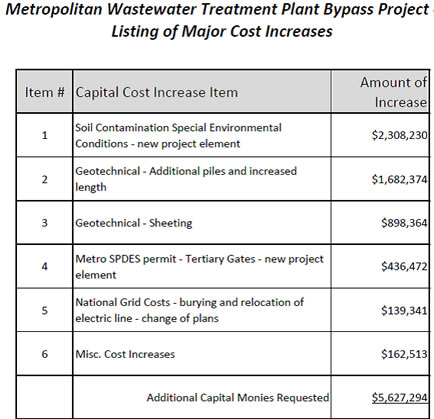
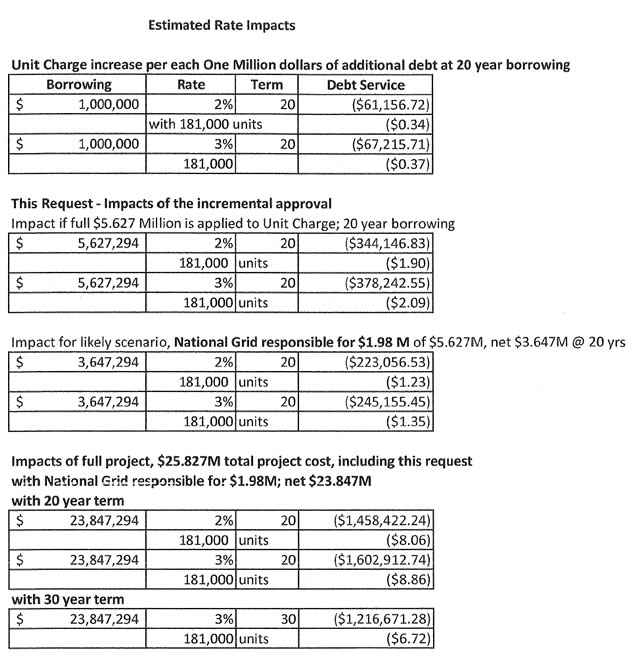
- EFC financing; $1.98M paid directly by National Grid, need full amount contract, 40 year usefulness
In answer to Mrs. Rapp, Mr. Rhoads said that he would get back to the committee with the current schedule for past debt. Mrs. Rapp said that this would be more palatable if they were paying off some debt before taking on more, to keep the rate flat.
In answer to Dr. Chase, Mr. Rhoads:
- National Grid pays directly as they go; won’t bond for that portion of the project
-
EFC allows 3 years zero interest for short-term loans; project rolls over for long-term financing with final construction costs, only borrow true costs; cannot exceed dollar amount authorized
-
Refinancing proceeds go into reserves for bonded debt; have 2 separate fund balances, built up reserve for ACJ work and have reserve for bonded debt;
In answer to Mrs. Rapp, Mr. Rhoads said that the amount in the fund balance would come from Management and Budget also. Mrs. Rapp asked if there was a possibility of taking the $5.6 million out of fund balance. Mr. Rhoads said that it might be better to use the reserve to periodically drawdown. At the end of budget there is always a discussion as to how much will be paid by the ratepayer and how much will be used from the fund balance to soften the impact of projects on the ratepayer. The graph shows the all in number for the project but the Legislature has other tools available to lessen the impact during the budget project.
A motion was made by Mrs. Rapp to approve this item.
In answer to Chair Plochocki, Mr. Rhoads confirmed that the project was mandated and needs to be done with haste in order to start construction September 1. The project must be online by April 1, 2017 to avoid penalty by the DEC. Chair Plochocki said that members of the caucus were also concerned about the foreseeability of the cost increase. They were not trying to get anyone thrown under the bus, understanding that from time to time cost estimates are wrong for one reason or another. The purpose of the question is to determine what they can learn from this. Mr. Rhoads:
- 2012 to 2015 went through more rigorous process of design; preliminary budget based on information available at that time, did not have extensive geotechnical work, building codes changed, Metro fell into different seismic code for the first time, resulted in significant increase to geotechnical support (Item 2 – see above graph)
- Additional geotechnical sheeting costs (Item 3 – see above graph) due to proximity of railroad and other utilities, along with poor soils, requires internal bulkhead instead of deadman anchor system; final survey showed 3 railroads, National Grid high-energy line and OCWA line
- Tertiary gates (Item 4 – see above graph), new DEC requirement June 2014
- Relocation of National Grid lines (Item 5 - see graph/pg. 2), preliminary engineering looked at Metro information, don’t have all surrounding utility information until final survey
- Soil contamination & special environmental conditions (Item 1 - see graph/pg. 2), largest item, $1.98M to be paid by National Grid; far right portion of campus previously contained a Niagara Mohawk manufactured gas plant, knew there were was significant environmental problems in that area, 2015 learned extent of the contamination, well beyond gas plant area, no way to see extent of contamination until final geotechnical information was completed, anticipated typical Allied contamination
- Misc. cost increase (Item 6 - see graph/pg. 2), all incremental costs increase as work takes longer
Chair Plochocki said that the County would outlay $3.7 million. Mr. Rhoads agreed. Chair Plochocki thanked Mr. Rhoads for his detailed explanation. Mr. Rhoads noted that he was happy they found this now, rather than during the construction phase.
In answer to Mr. Burtis Mr. Rhoads:
- Anticipate disinfection and dechlorination completion February 27, 1 month for startup and testing, actual project closeout – mid to late 2017 for final site cleanup, demobilization, grass planting, etc.; haven’t bid, don’t know contractors true schedule
- Bonding 40 year period of practical use (PPU), cannot borrow longer than PPU
Seconded by Dr. Chase. Passed unanimously; MOTION CARRIED.
c. A Resolution Authorizing the Issuance of an Additional $5,627,294 Bonds of the County of Onondaga, New York, to pay the Increased Cost of Bypass Treatment Improvements at the Metro Wastewater Treatment Plant in and for the Onondaga County Sanitary District ($5,627,294)
A motion was made by Dr. Chase, seconded by Mr. Shepard, to approve this item. Passed unanimously; MOTION CARRIED.
3. OFFICE OF THE ENVIRONMENT: Travis Glazier, Director; Mark Donnelly, Executive Director OCRRA; Amy Miller, Agency Engineer OCRRA; Jeremy Boylan, Clerk of the Legislature; Philip T. Krey, Highway Superintendent
a. Adopting the Onondaga County Local Solid Waste Management Plan
Chair Plochocki said that the Solid Waste Management Plan (SWMP) was discussed and unanimously approved by this committee in February but did not go to session. It has now returned for a vote at the June session. There have been no changes to the SWMP since the approval; therefore, a vote is not necessary for this item.
Mr. Glazier:
- Original SWMP passed in 1991, Nov. 2014 Legislature considered update to SWMP, changes presented to committee, SEQRA resolution passed in Dec.
- Public comment period from Dec. to Jan, public hearing held Dec. 16; most comments related to increasing recycling and the Waste-To-Energy Facility (WTEF), crossover comments related to Cortland County Partnership; SEQRA process for partnership ran parallel to SWMP
- DEC reviewed plan, sent letter of approval for amended SWMP Feb. 9, had minor technical changes reflected in errata sheet, primary changes related to past tense and present tense language; no substantive changes were fund, changes were made and errata sheet was included at Feb. committee to illustrate changes
- Had 60 day window for approval, asked DEC for extension, David Vitale indicated this was not a problem, asked that the DEC be kept in the loop – only change since Feb. committee
In answer to Chair Plochocki, Mr. Glazier confirmed that there are no changes to the SWMP, simply the approval window as explained.
Chair Plochocki asked that they continue to keep in mind his comments from the February minutes and read the following, “Chairman Plochocki said for the record, he wants to make sure they are absolutely clear that the Solid Waste Management Plan (SWMP) is not being revised because of the potential ash for trash partnership with Cortland. Periodically the plan needs to be revised, and with all due respect to the County, probably should have been revised before this. Because they are aware that the partnership is a potential reality, the amendments to the SWMP contemplate that future possibility. Chairman Plochocki feels that this is a good idea, in other words contemplating the possibility. If something may be a foreseeable possibility, and they are amending any plan, that plan should take into account such things. He asked that committee members keep this in mind as they move forward.” Though they are not voting on this today, it is important to keep this in mind for discussion purposes.
Dr. Chase said that she was confused. Her understanding was that the Cortland partnership was an integral part of where they are now with the SWMP, it was not A and B, it was all one thing. Mr. Donnelly said that the SWMP was drafted so that it was not one thing, it is either/or. The options are clearly defined and if they do not partner with Cortland, the SWMP can stand on its own without any changes. If the Legislature decides to go with Cortland, it is comprehensive to include the Cortland program.
Dr. Chase said that when they vote on this item, they are voting on extending their relationship with Covanta as is, considering that the third bay is empty most of the time. Then there will be another vote to agree upon the partnership with Cortland County. Mr. Glazier said that there is a local law that prohibits importation. Dr. Chase said her understanding was that the permit for Covanta was good until August 2016. Ms. Miller:
- Dr, Chase referring to the Title V air permit, 5 year permit; 6 months in advance of expiration submit request for renewal
- Also have Part 360 solid waste permit, 10 year permit, expiration approximately 2020 – 2021; permits are unrelated to the SWMP, go through annual process for them
Dr. Chase said that her understanding was that they would have to apply for a different permit, if they take in Cortland County trash. Ms. Miller:
- No changes needed to permits for the WTEF, not asking to increase capacity processed annually, don;’t need approval from DEC
- Importation Law must be addressed for partnership to move forward
- SWMP approved by DEC, letter provided to committee in Feb.
Dr. Chase said that she spoke to someone at DEC about two months ago and they said that if there was any considerable change to the way they are permitted, which taking another county’s trash would be, they would have to apply for another permit. Ms. Miller said that they have been in close concert with DEC and DEC is generally supportive of this project. The communications to OCRRA has not indicated any changes are needed. Key solid waste personnel are aware of this and Ms. Miller is not sure where this information came from.
Chair Plochocki reiterated that if the SWMP were approved at session it would not need amending, with or without the Cortland County partnership, as it contemplates foreseeable alternatives. Mr. Donnelly agreed. In answer to Dr. Chase, Mr. Donnelly said that the vote on the SWMP was not codependent on future votes for the importation law or the findings statement. The SWMP stands on its own and does not obligate the Legislature to the Cortland partnership. Dr. Chase said that approval of the partnership would require a vote to change the importation law and a vote to approve the partnership with Cortland County. Chair Plochocki agreed.
In response to Mrs. Rapp, Chair Plochocki said that due to a technical error the agenda originally listed the findings report. He apologized for the error, noting that the fault was his. If they go ahead with things, it will come back.
Dr. Chase:
- Spent much time listening to Onondaga County constituents’ concerns, feels constituents are owed a general health risk assessment; SWMP requires reporting to DEC every two years, not enough if they do not have a big picture to start with, last assessment from 1989, before Covanta opened their doors
- General health risk assessment would provide information as to where they are now, down the line if they take in Cortland, will be able to show it has not made a difference in the way they have been operating
Mr. Burtis asked how much it would cost and who would pay for it. Dr. Chase said that she has not been able to get a straight answer. The 1989 assessment cost approximately $350,000. It was not cheap, but the health of constituents is important. In answer to Mrs. Rapp, Dr. Chase said that she had no idea where the $6 million figure came from. Dr. Chase said that she met with various people to see how much help they could get. ESF just hired someone from SU that has been looking at different ways to rid trash and she hopes to be able to spend some time with him. Mrs. Rapp said that it would be interesting to know where the $6 million figure came from. Dr. Chase said that no one could tell her where the number came from. Chair Plochocki said that sometimes the lines are blurry as to what committee a subject area should go to; the Health Committee has been addressing this issue. Nothing final has been decided but he would rather that this discussion stay with the Health Committee. For now, he would like to stay focused on the SWMP itself.
Mr. Donnelly said that there was some question from the Legislature with regard to Cortland County’s recycling program. Chair Plochocki asked that Mr. Donnelly introduce the members of the board of directors present, for the record. Mr. Donnelly introduced Ravi Raman, John Copanas and Mary Beth Primo; both men are 10-year members and all are 100% up to speed on this program. Under their scrutiny and direction, OCRRA worked diligently with Cortland County to establish clearly defined strong mechanisms to improve recycling. Cortland County has a good recycling program today but can improve; OCRRA just won a best in class national award among 70 different applicants from across the US. Cortland County is a very willing partner, as reflected in the proposed contract. The proposal will provide Cortland the necessary resources and ability to draw on OCRRA’s 20-year process of building an award-winning program. Two representatives from Cortland County are present today.
Chair Plochocki asked that Mr. Donnelly introduce the guests from Cortland County, for the record. Mr. Donnelly introduced Mr. Jeremy Boylan, Clerk of the Legislature and Philip Krey, Highway Superintendent.
Mr. Boylan:
- Have had good experience with meetings and negotiations with OCRRA; look forward to being able to take part in OCRRA’s expertise
- Cortland County has a good quality recycling program, mandated issue in solid waste law; adopted SWMP in Dec., included possibility of Onondaga County partnership
- 3 municipally funded curbside pickup recycling operations, located in 3 most populated areas - City of Cortland, Village of Homer and Village of Marathon
- Recycling center open daily for residential use and for commercial haulers not municipally funded
Mr. Krey:
- e-waste disposal available at no charge to community, also battery recycling
- Annual Household Waste Day, funding opportunity with DEC, 50% matching grant
- Active in recycling, don’t have hard numbers, looking forward to being able to answer that question
Mrs. Rapp asked if the requirements would be the same for Cortland County as they are for Onondaga County, and if the WTEF would be burning the same trash. Mr. Donnelly said that they put some strong teeth into this and focused on the things that they are concerned about in their emissions, i.e. mercury – lamps, thermometers and thermostats come to mind. Part of the contract is to build a robust program with Cortland County to recycle those materials and Cortland has already jumped on to the household hazardous waste program that Onondaga County has. In the spirit of that partnership, OCRRA was able to negotiate the volume rates they get for Cortland.
Mrs. Rapp said that in essence they would not be taking things from Cortland County that they would not take from Onondaga County. Mr. Donnelly said that Mrs. Rapp was 100% correct. One of the benefits of it taking a while for Cortland County to put their infrastructure together is that OCRRA will be able to put programs in place for the gaps that they have, which aren’t many. Mrs. Rapp said that this was a concern. Mr. Donnelly said that it was a concern for the OCRRA board and agency as well.
Chair Plochocki asked if it was both OCRRA’s and Cortland County’s understanding that Cortland was going to move to have the same standards of recycling and hazardous material, as soon as practicable, if the partnership goes forward. Mr. Donnelly:
-
Quick answer yes - for training, public education and setting up the systems
-
Human behaviors change more slowly, see this within Onondaga County when they make a change; will have to beat the streets with all the same communication that OCRRA’s communication officer provides to train them
-
OCRRA has committed a substantial amount of time to get programs up and running, not quantified in hours, Corltand County won’t have to hire a consultant, OCRRA is qualified, awarded best in US and has resources available, doesn’t have to hire
Mr. Boylan:
- Cortland already going forward regardless of the partnership, created full time position - solid waste manager, will take on some responsibility for education and outreach
- Expect Legislative Chair to appoint committee of outside agencies this month, will work together for communitywide partnership in all types of green aspects and programs; absolutely committed
Chair Plochocki said that this was fantastic.
Mrs. Rapp said that there was talk of expanding the burning of c&d materials. Ms. Miller said that the materials would go to the Ley Creek transfer station for separation, just as they do for Onondaga County. They are not changing the standards.
Dr. Chase said that she would encourage this committee, or the Legislature as a whole, to keep up on other options for trash removal before the next contract. Burning has become accepted but many things have changed over the past 20-years. Chair Plochocki said that they should always be looking for the best methods of trash disposal and recycling. Mr. Glazier said that the SWMP speaks to their concerns and outlines what the goals are, i.e. OCRRA is looking at Pay-As-You-Throw case studies. Ms. Miller:
- Pay-As-You-Throw systems make people aware of the amount of trash generated, pay by amount
- Reviewing systems within Onondaga County, develop page with lessons learned, what’s working and what is not; communities that don’t have a program might look to communities that do; summer case study
Mr. Donnelly:
- OCRRA actively looking at options, i.e. food waste; nationally 15% of the trash
- OCRRA driving program to bring food waste to Amboy facility, amazing number of volunteers – all hospitals and universities, making big movement with high schools, even smaller places, i.e. Pastabilities
- Repurposed full circle into nutrient rich compost, amazing ¼” screen product, sells quickly, year round sales, peak season April – Sept.
- Tours available for any OCRRA facility, bring boots, will provide remaining safety gear
Chair Plochocki said that he and Dr. Chase took a tour and it is an outstanding facility.
Mr. Donnelly:
- Run programs with charities to divert textiles from the waste stream, i.e. stained tee shirts converted to dollars, sold and recycled into other material; can’t be placed in blue bin
- Building programs to remove items from waste stream and into reuse/repurpose stream; slow process, got here over 20 years, proud of their success, will continue
The meeting adjourned at 10:13 a.m.
Respectfully submitted,

KATHERINE M. FRENCH, Deputy Clerk
Onondaga County Legislature
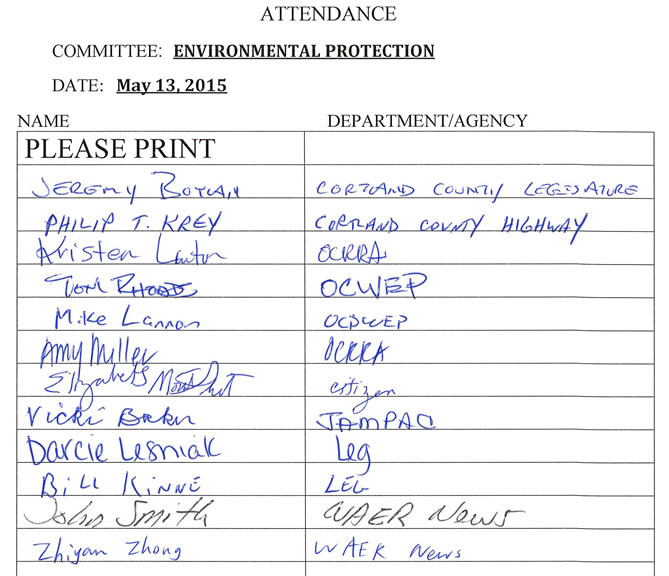
* * *
PUBLIC SAFETY COMMITTEE MINUTES - MAY 13, 2015
BRIAN MAY, CHAIRMAN
MEMBERS PRESENT: Mr. Ryan, Mr. Dougherty, Mr. Jordan
MEMBERS ABSENT: Mr. Holmquist,
ALSO ATTENDING: See attached list
Chair May called the meeting to order at 11:10 a.m.
A motion was made by Mr. Jordan, seconded by Mr. Dougherty, to waive the reading of the proceedings from the previous committee minutes. MOTION CARRIED. A motion was made by Mr. Jordan seconded by Mr. Dougherty, to approve the minutes of the proceedings of the previous committee. MOTION CARRIED.
1. SHERIFF: Kenneth Andrews, Chief/Civil;
a. 2015 Sheriff’s Transfer Resolution ($408,700)
Chief Andrews said that he understands and respects what Legislators are up against with the budget but feels that basic supply funds should not be in contingency. They are items needed to run the jail, i.e. Toilet paper, uniforms, training ammunition, etc. Requesting the funds is a 3-month process and they cannot operate without the supplies. As they go into the next budget session, he would like to have conversations about what is placed into contingency. Chair May said that the Chief was spot on. The budget for 2015 was based on a couple of things, one being a dozen or more years of substantial overruns requiring the legislature to appropriate fund balance to shore things up. The approach in 2014 was much more stringent and got the department across the finish line with a balanced budget. It did its job for the taxpayer. He does not think anyone enjoys taking about men’s briefs, tampons, socks, towels, sheets, razors, etc. It is not fun and is certainly not legislative business but they avoided what has traditionally been anywhere from $1 million to $2.5 million in cost overruns.
Mr. Dougherty said that he hopes everyone remembers this during the budget process as there is a lot that can be done differently in the development of the 2016 budget. Chair May said that 2015 is more relaxed than 2014, which was an arduous process. Mr. Dougherty said that much more was put into contingency in 2015. Chair May said that they applied the contingency tool more universally in 2015. Mr. Dougherty said that there are things that should be in contingency and the rest was swept in.
Chief Andrews reiterated that he would like to have a conversation about the supply contingency. Mr. Ryan said that he appreciated the candor. Initially he had reservations but this plan seems to have worked for the Sheriff’s department. He has been a constant advocate, making sure the Sheriff’s department gets all of the resources needed to conduct business. At the same time, Legislators work hard to reduce the tax levy through the budget process, only to have people greatly overspend their budget, which wipes out what Legislators have done. For that action, there is a reaction. It may get better but they will still have to do some of this. Chief Andrews agreed, adding that this was a new team and the Legislature needs to see how they perform.
Chair May said that tactically they are talking about items on the supply list. Strategically they are looking at the year-to-date budget for critical accounts and where they think they will end up These are benefits of this process, which were not done in the past, that help legislators to understand how things are going and what to expect downstream. Some lines are running hot that they do not typically have control over. Chief Andrews:
- Overtime custody one item, big issue, not an easy solve; all know discussion on solving constant watch, with warm weather have huge number of constant watches , one-on-one situation, much overtime, nothing they can do about it
- Understands analytics used to determine overtime for budget process were good, Legislature then cut the budget by $500,000; don’t know how to reduce overtime without changing physical facilities, building doesn’t meet current demands, change is needed
Mr. Jordan asked where they where on this project. Chief Andrews said that last year during the budget process he heard Chief Gonzalez provide a short report on that topic to the Legislature. When Sheriff Conway came in, he asked Chief Gonzalez to put all the options together for his review. Chair May asked that they hold off on this question for a little bit. He would like to get through this item first.
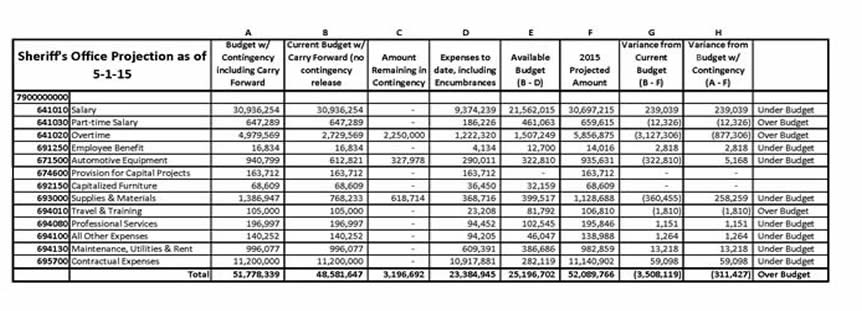
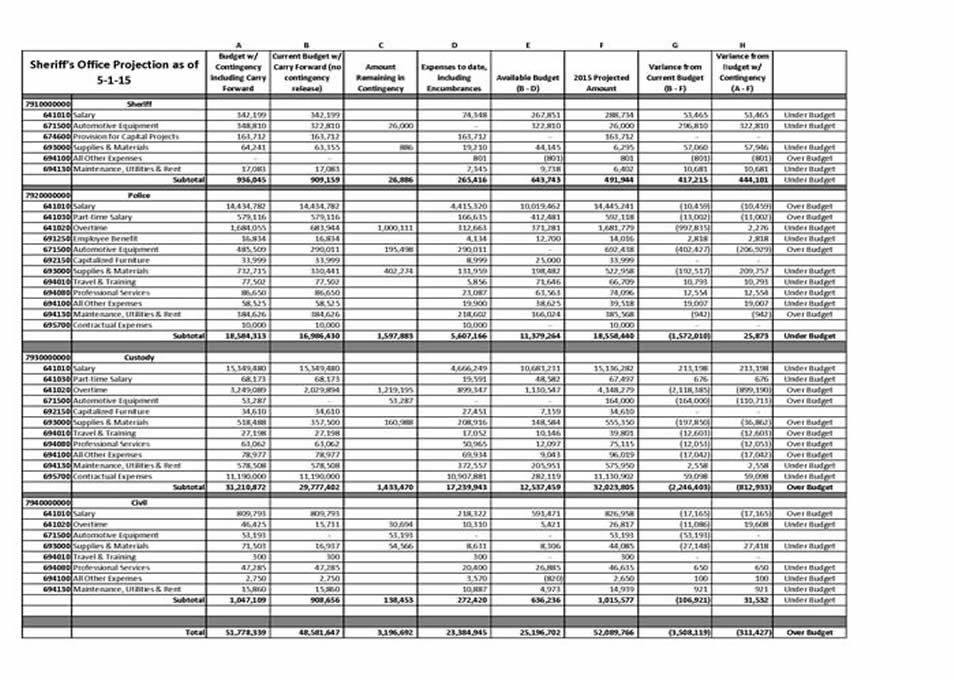
Chair May reviewed the projections (see graphs pg.2), noting custody was projected to run over by $900,000 with road patrol slightly under. In answer to Chair May, Ms. Fricano said that the surplus in supplies was mainly due to the purchase of cars, automotive supplies that will not have to be expended. Chair May said that at year-end they would be doing adjustments based on the finance strategy used for the first round of cars in 2015. Currently the department is forecasting to be over $300,000+. He asked if this took into consideration the remainder of the vehicle request. Ms. Fricano said that the projection zeroed out the contingency. Mr. Dougherty said that they are assuming contingency funds will be released into each of the accounts as budgeted, which is probably fair.
Mr. Dougherty said that when you consider that they are dealing with almost $52 million, the $300,000 works out to .6%, which is pretty good. Chair May said that they were doing great. They are on task because the Legislature knows what is happening with the budget. Mr. Dougherty said that they were going to shot themselves in the foot if they focused on the $300,000, rather than where they could make cost savings or some type of strategic change to reduce the costs for next year. Chair May agreed.
A motion was made by Mr. Dougherty, seconded by Mr. Jordan, to approve this item. Passed unanimously; MOTION CARRIED.
Mr. Ryan said that the driving force in the overage is custody overtime. To Legislator Dougherty’s point, this is a good story; it is a little bit of money, in a very large budget. The good news is that that know where to fix this, the bad news is that it is a very large discussion as to how to fix it.
Chief Andrews:
-
Fix is not fast, problem will never get fixed if they don’t get started – continued overcrowding, in ability to house federal prisoners and one-on-on constant watches
-
Up to the department to get up to speed ASAP, then talk with County Executive and Legislature to move forward; Sheriff reviewing information from Chief Gonzalez
Chair May:
- From Public Safety prospective have talked about Mental Health each month, knew County Executive’s office had different prospective - didn’t know what, knew things stopped, knew they had a new Sheriff
- In response to last committee discussion, asked Ms. Rooney to sit down with the Sheriff and himself to round table where they are at; his goal was to express to the Sheriff the collective desire to move forward and try to solve this, spent time quantifying costs and how it is hurting taxpayers, his comments showed deference -Sheriff’s decision as to how he wants to manage these problems, his expertise
- Ms. Rooney echoed many of the same thoughts, both stated they were behind the Sheriff, want him to move forward, money authorized to begin process, looking for Sheriff’s thoughts, ideas and opinions on how to move forward; intends to respect opinions in the final analysis - can’t speak for entire committee
- Chief Gonzalez was present, shared extensive analysis completed on this subject; Chair brought in Probation to discussion things happening there
- Bottom-line gave the Sheriff the key to press on, all looking for his advice
In answer to Mr. Jordan, Chair May said that they did not have a timetable but this is a top priority for the Sheriff and he believes it is a top priority for everyone. Mr. Jordan said that the County is hemorrhaging money because of this. Chair May agreed, adding that everyone needs to be at the same table moving forward with the person in charge taking the lead, rather than having different groups with different and disparate concerns. This is the Sheriff’s scope of authority. There was a very productive meeting, opening the lines of communication.
Mr. Dougherty asked if there was any conversation with DA. Several years ago, they talked about faster processing through the jail, which seems to have gone by the wayside. He has not heard anything about this in 2-3 years. He understands that the state has an issue with video arraignments but he believes that there is room for improvement. Perhaps the current Sheriff and the DA could try to improve this situation. Chief Andrews said that he would bring this back to the Sheriff so that they could at least have a conversation.
Chair May said part of the purpose for the initial meeting was to get at the same table to establish authority and leadership. In his opinion, not only the DA but also many other touch points of influence need to be brought in however, it is the Sheriff’s prerogative. It seems to make a lot of since for the DA, Justice Courts, Mental Health professionals and Probation to be involved. He hopes that the initial meeting paved the way for opportunities to involve these people at the same table, as opposed to everyone expressing opinions from their island and nothing getting down, as evidenced by the past 2 years.
Mr. Dougherty said that anecdotally he hears stories about judges arraigning someone for a relatively minor nonviolent crime and setting huge bails. The person ends up spending several days in jail at taxpayer expense. If released with a reasonable bail, or some other arrangement, the bed could be emptied. Mr. Jordan said that they could not dictate what a judge does; all they can do is ask that they be more reasonable. Then it is up the family to come up with the money to get them out. Mr. Ryan said that there is also the other side. His constituents see the same people dealing drugs in the same location, every day of the week. The day after arrest, they are back doing the same thing. The point of his comment is that this needs to be inclusive and they must find a better way to do this.
Chair May said that Ms. Rooney leads the Criminal Advisory Justice Board, which he sits on. There was enlightenment at the last meeting, as all the people just mentioned are at one table to talk about routine business of this community with respect to the jails and justice courts. Three judges were present to hear the costs of a weekend sentencing to corrections and/or custody, not only the cost of housing but finding a place for that person, i.e. female, could be at capacity, have to reshuffle entire deck. Mr. Dougherty said that he would love to see that push before starting. He is in favor of building the extra wing and reconfiguring the jail but it seems like a very expensive approach when it may not be necessary.
Chair May said that the Legislature is supposed to receive a massive binder of analysis, which he thinks they will get digitally. Everyone will be able to peruse the information and perhaps form better opinions as to what should be done. He is not predisposed to anything and feels that they have not come far enough to have an understanding; knows that they have to solve the problem but cannot say much beyond that.
Ms. Rooney:
- All have touched on different faucets of the issue
- Tremendous amount of work done over the last couple of years to determine why length of stay increased dramatically for accused, many reasons for it, not just courts, defense attorneys let people sit there so that judges will award time served; Probation works to remove anyone in the Justice Center for a technical violation each day
- Many points to this, Criminal Justice Advisory Board perfect venue to address much of this; DA big piece of this puzzle also, many touch points to this
- Need to work with Sheriff to build something that will last for 20 years; time spent looking at all the issues benefits them
Chair May said that the meeting was a good start and was something that had not happened before.
Chair May:
- Distributed resume (On file with the Clerk) for Emergency Management position; won’t be voting today
- Don’t’ want position vacant too long, learned about candidate late last week, had phone interview
- Want committee to have time for research and review, candidate firefighter in Legislator Dougherty’s district, good academic background; hope to vote on position at Ways & Means
Ms. Rooney:
- Abruptly lost Kevin Wisely to promotion with NYS, weren’t thinking of replacement, took step back to consider what they should look for and any missing pieces they would like to fill
- Conducted expansive search, reviewed over 100 resume’s Feb. – March, worked with Personnel to pare down top 11 candidates
- Peter Troiano, Bill Bleyle and Ms. Rooney interviewed candidates from all different walks of life – military, police, fire, and EMS; Daniel Wears quickly rose to the top amongst all three of them
- After interview process quickly agreed that although young in age Mr. Wears has had a fire in his belly for Emergency Management coordination since college; 2008 received Master of Public Administration from SU, did internship with Onondaga County Emergency Management, responsible for coordination of IATSE grants as a student, finished degree, came back and worked again for the county in Emergency Management, worked with both Peter Alberti and Kevin Wisely, received rave reviews across the board, went onto Washington, now the manager of Emergency Management at SU
- Management credentials in addition to practical work with Moyers Corners and Tauton Fire Depts., in addition to exercises at SU
- 2008 County Executive said she wanted to hire the best and brightest, believe this is what they will be getting with Mr. Wears
Chair May said that anyone who interns with the police department in high school must be into public safety. Ms. Rooney said that during the interview process Mr. Wears said that from the moment he started volunteering he had a passion and really clicked with the Emergency Management coordination piece. Tony Callisto from SU said the only bad thing he can say about Mr. Wears is that he is going to lose him. He has brought the organization leaps and bounds from where they were in preparation for an emergency. Mr. Dougherty said that this was a good recommendation.
The meeting adjourned at 11:50 a.m.
Respectfully submitted,

KATHERINE M. FRENCH, Deputy Clerk
Onondaga County Legislature
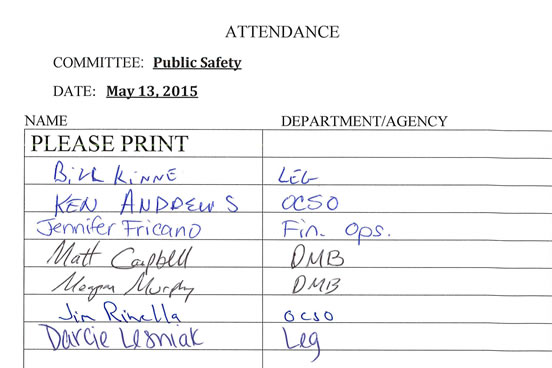
* * *
COUNTY FACILITIES COMMITTEE MINUTES - MAY 13, 2015
JUDITH A. TASSONE, CHAIR
MEMBERS PRESENT: Mr. Dougherty, Mrs. Rapp, Mr. Ryan, Mr. Shepard
ALSO PRESENT: see attached list
Chair Tassone called the meeting to order at 10:38 a.m. A motion was made by Mr. Dougherty, seconded by Mr. Shepard, to waive the reading and approve the minutes of the proceedings of the previous committee meeting; MOTION CARRIED. A motion was made by Mrs. Rapp, seconded by Mr. Dougherty, to approve the minutes of the previous committee. MOTION CARRIED.
1. TRANSPORTATION: Brian Donnelly, Commissioner
a. Authorizing the Acquisition of Real Property Necessary for the Jordan Road Bridge Over Skaneateles Creek Project, PIN 3754.77, County Bridge C-80, BIN 3313110, in the Town of Skaneateles, County of Onondaga
- Items a & b deal with a Federal Project, Jordan Road Bridge over Skaneateles Creek
-
Authorizing three temporary easements needed to construct the project, received notification from all three owners that because of the value of the properties, not expected to go over $300 - $400, they are all going to donate the properties
- Expect to have the signed donation forms by Ways & Means
- Part of the stipulation with the donation is that there are no appraisals
- Maps still need to be filed, Legislature needs to approve the temporary easements, but there won’t be any costs
Mr. Dougherty questioned why an owner would donate. Mr. Donnelly said that they are small parcels. One is an easement from the Town of Skaneateles, which is going to benefit from the project - helping redo a pedestrian bridge. Stauffer Chemicals is a super fund site, again it is a small area and it too is in their benefit to have this done – it will prevent them from having the bridge fall into disrepair and having to deal with a remedial situation because things such as footings or abutments are crumbling. One property owner’s portion is very small, so they agreed to donate.
In answer to Chair Tassone, Mr. Donnelly said the property is approximately where Jordan and Stump Roads come together, north of the Village of Skaneateles, within the Town of Skaneateles.
A motion was made by Mrs. Rapp, seconded by Mr. Shepard, to approve this item. Passed unanimously; MOTION CARRIED.
b. Amending the 2015 County Budget to Fund in the First Instance 100% of the Federal Aid Eligible Costs at a Maximum Amount of $8,000 for the Right Of Way Acquisition Phase of the Jordan Road Bridge Over Skaneateles Creek Project, PIN 3754.77, BIN 3313110, and Authorizing the County Executive to Enter Into Agreements to Implement the Intent of this Resolution ($8,000)
- Covers the cost of negotiations, R. K. Hite & Co., Inc. was hired to negotiate with the property owners
- $10,000 - total; $8,000 – Federal; $2,000 – local - will be reduced by $3,000 because we won’t be paying for the easements
- Resolution should be amended by Ways & Means
Chair Tassone asked if the local costs would be reduced; Mr. Donnelly responded that it was $2,000-20% of the $10,000, and now it would be 20% of the $7,000.
A motion was made by Mr. Shepard, seconded by Mrs. Rapp, to approve this item. Passed unanimously; MOTION CARRIED.
c. Amending the 2015 County Budget and Authorizing the County to Pay in the First Instance 100% of the Federal and State Aid Eligible Costs at a Maximum Amount of $3,562,500 and Authorizing the County Executive to Enter Into Agreements for the Northern Boulevard Safety/Paving Project, PIN 3754.65 ($3,562,000)
- Authorizing payment in the first instance for the construction phase of a Federal Aid project on Northern Boulevard, between Molloy Road and Taft Road.
- Northern Boulevard went out to bid late last fall: expected to start next spring
- Will be resurfaced, some limited full-depth reconstruction, replacing two large culverts south of Taft Road
- Estimated cost is $3.75 million – 80% Federal, 15% State, and 5% local
In answer to Mr. Ryan, Mr. Donnelly said that part of the safety analysis was reviewing the little notch where Northern Boulevard and Taft roads come together, there was a possibility of an inclusion of a roundabout. Roundabouts have a safety impact but they are relatively expensive to build. As part of the analysis of this project, it was found that by making it a controlled stop rather than yield, it would dramatically reduce the number of accidents there and the level of service would stay manageable. The cost of a roundabout was avoided and traffic is moving through there pretty well.
Mrs. Rapp said that the roundabout would be a lot less complicated. Mr. Donnelly responded that it would be much more expensive – part of the Federal process when doing reviews for a safety analysis is asking what the goal is. To reduce the accidents and improve level of service, and to do it as cheaply as possible. Roundabouts are relatively expensive to install, would have to purchase a right-of-way and stop signs, with the two years of experience, it has functioned well there.
Mr. Dougherty asked if they were going to lay things out differently to simplify the intersection beyond the stop sign. Mr. Donnelly responded that he didn’t think so, the alignment and lay out will remain the same.
Mrs. Rapp asked if they were just paving, and Mr. Donnelly responded yes. The work is already done at that little juncture, so the rest of the project is paving and drainage.
A motion was made by Mrs. Rapp, seconded by Mr. Dougherty, to approve this item. Passed unanimously; MOTION CARRIED.
The meeting was adjourned at 10:44
Respectfully submitted,

KIMBERLY A. MEMORY, Assistant Clerk
Onondaga County Legislature
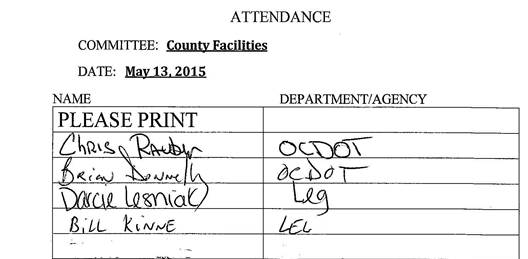
* * *
PLANNING & ECONOMIC DEVELOPMENT COMMITTEE MINUTES - MAY 14, 2015
KATHLEEN A. RAPP, CHAIR
MEMBERS PRESENT: Mr. Liedka, Mr. Burtis, 1Mr. Knapp, 2Mr. Plochocki
ALSO ATTENDING: Mr. Shepard, Chairman McMahon, Dr. Chase and see attached list
Chair Rapp called the meeting to order at 10:04 a.m.
A motion was made by Mr. Liedka, seconded by Mr. Burtis, to waive the reading of the proceedings from the previous committee minutes. MOTION CARRIED. A motion was made by Mr. Liedka, seconded by Mr. Burtis, to approve the minutes of the proceedings of the previous committee. MOTION CARRIED.
1. SYRACUSE-ONONDAGA COUNTY PLANNING AGENCY: Don Jordan, Deputy Director-GIS
a. Approving the Inclusion of Viable Agricultural Land within Certified Agricultural Districts Pursuant to Section 303-B of the New York State Agriculture and Markets Law
Mr. Jordan:
- Annual open enrollment Jan. 1-30; received 8 property request from landowners, total 258 acres, Farmland Protection Board reviewed request and recommended additions
- Public hearing to be held prior to June sessio
A motion was made by Mr. Burtis, seconded by Mr. Liedka, to approve this item. Passed unanimously; MOTION CARRIED.
2. Requesting that the New York State Public Service Commission to Consider Objections of Residents and Provide a Mitigation Plan to Minimize the Negative Impacts of the Proposed Transmission Line on Residents of the Town of Elbridge in Onondaga County (Sponsored by Mr. Shepard)
Chair Rapp took the agenda out of order to allow Mr. Shepard to discuss both of his items together.
Mr. Shepard:
- Approached by Mayor and resident of Elbridge, informed NYSEG has proposal to bring new power line between Auburn and Elbridge stations, residents want the Public Service Commission to require any approval to be as tight to existing easements as possible, rather than taking any new property
- Resolution substantially the same as that passed by the Cayuga County Legislature
A motion was made by Mr. Liedka, seconded by Mr. Burtis, to approve this item. Passed unanimously; MOTION CARRIED.
1Mr. Knapp arrived at the meeting.
7. Memorializing the New York State Legislature to Enact Senate Bill No. S. 02250 and Assembly Bill No. A.02114 Authorizing Industrial Development Agencies to Provide Assistance to Agricultural Producers (Sponsored by Mr. Shepard)
Mr. Shepard:
- Senate seeking to expand definition of industries with access to IDA support, adding agriculture; bill passed in the Senate, headed to Assembly
Chair Rapp said that they support some agriculture with all the yogurt plants and Byrne Dairy has gotten benefits from the IDA, perhaps under manufacturing, specifically what would be different. Mr. Shepard referred to the 4th whereas clause: “WHEREAS, the proposed legislation would add a definition of “agriculture” or “agricultural” that would include “the production of any agricultural, horticultural, floricultural or aquacultural product of the soil or water that has been grown, harvested or produced within the State, including, but not limited to fruits, vegetables, eggs, dairy products, meat and meat products, poultry and poultry products, fish and fish products, grain and grain products, honey, nuts, preserves, maple sap products, apple cider, and fruit juice and includes the commercial raising, shearing, feeding and management of animals on a farm or ranch”.
Chair Rapp said that this is one of the targeted industries for growth in NYS.
A motion was made by Mr. Knapp, seconded by Mr. Burtis, to approve this item. Passed unanimously; MOTION CARRIED.
3. INFORMATIONAL - Tiny Houses: Andrew Lunetta, Executive Director; Robert DeMore, Director Community Development
Mr. Lunetta:
- Distributed memo from Mr. DeMore, GIS photo, site photos and brochure (On file with Clerk)
- Has been in Syracuse 6 years, as student of LeMoyne College worked closely with homeless at Oxford Street Inn Homeless Shelter run by Catholic Charities; Masters at Maxell
- Started Pedal to Possibilities offering group bike rides to homeless, then invited individuals facing homelessness to move in with him for past 2.5 years
- Lack of appropriate housing for those facing homelessness, affordable housing was worse than the shelters, people would end up back at the shelters after spending a small amount of time in bottom-of-the-barrel apartments; last year formed A Tiny Home For Good, Inc. and developed a board
- Raising money to build homes, making partnerships with case management agencies and builders, i.e. Operation Northern Comfort; finding suitable property difficult for 1st build, couple close calls, things didn’t work out with neighbors or there were zoning regulations; contacted Mr. DeMore about 4 contiguous properties owned by Onondaga County on W. Kennedy Street, property was for sewage treatment facility that never happened, zoned for their needs, want property transferred to A Tiny Home For Good
In answer to Chair Rapp, Mr. DeMore said the property they are discussing today is for veterans homes. Mr. Liedka asked if there would be jobs or skills training to go along with this. Mr. Lunetta said that there would not be specific requirements but they would be connected to a case management organization. A rent subsidy will be given to those that follow through with what the case management organization is doing. Regimented requirements hasn’t work well for residents facing homelessness but the rent subsidy is a big piece.
Chair Rapp said that this would be different from the Rescue Mission, which is pretty ridged. Mr. Lunetta agreed, adding that those housing the homeless do a really good job, especially at doing what they are doing. He has talked with Catholic Charities and the Rescue Mission and a big missing piece is this affordable housing, which they are trying to provide.
Chair Rapp asked of there would be screening. Mr. Lunetta said that initially the VA or Onondaga Case Management will contact them with on behalf of homeless persons they are looking to house. They will meet him and go on from there. Initially homes will be offered to males but he would like to see it offered to females as well.
Mr. DeMore:
- VA has some houses, tiny home more conducive to independent living than complex; have talked with Commissioner Merrick and the VA
- 2 small lots assessed at $2,000 each - market value $2,400, large lot accessed at $5,000 – market value $6,135, no real value; sitting unused for 15 years as purpose changed, area private and off by itself in the middle of a City, creek located in back, vacant property across the street, everything around it has been torn down
Mr. Liedka said that he was thrilled to hear the veteran component and asked how the process works for selection, as there is an overwhelming need. Mr. Lunetta said that it would be on a first-come first-served basis, once they have more units. The VA or case management organization will request a unit and the person will sign the agreement to live in a 250 square foot space.
In answer to Mr. DeMore, Mr. Lunetta confirmed that they have upfront money to build the structure and where not looking for funds from the County, just the surplus lots.
In answer to Mr. Knapp’s questions. Mr. Lunetta:
- 4 units on these lots, 2 2-unit structures, had to butt housing together per zoning, would have liked 4 separate units
- City on board, held 2 predevelopment meetings, City asked that they come back after this meeting
- Set of units on each of the smaller lots, garden for larger lot
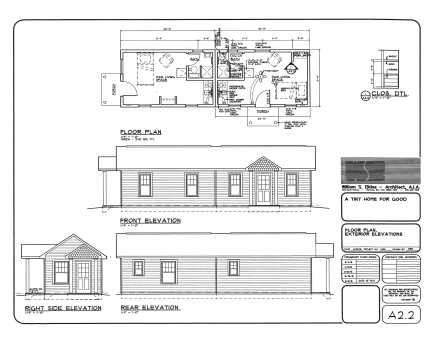 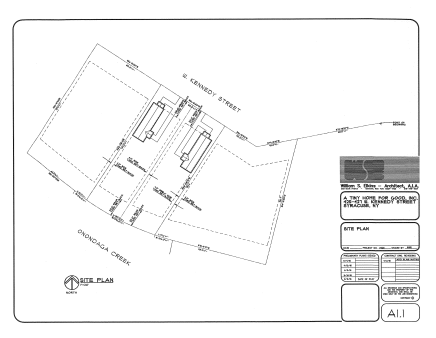
Mr. DeMore said that if this works there is a piece of property around the corner, on Martin Luther King that would be nice. It is the same situation, where the land was bought for the sewer treatment plant and never used.
Chairman McMahon asked what type of community engagement and outreach had been done. Before they even knew this was coming up on the agenda, they had people concerned about this at the last legislative session. He asked if the district councilor was on board. Mr. Lunetta said that he has not done community outreach for this property. Back in November, they almost had property on the near Westside of the City. He reached out to the community before they had the property. It got really ugly, very quickly and was a large part of the reason they did not receive the property from the City. If the property is obtained, before they put a shovel in the ground, community outreach will be priority number one for himself and the board. He understands that there will be a fair amount of pushback because the word homeless has a bad stigma to it. If this is done right, with only four units in one neighborhood, it is more effective than an apartment complex.
Chairman McMahon said that there will always be naysayers. He recommends that they reach out to the community as these lots will require action from the Legislature in order to sell them for a dollar. Mr. Lunetta said that he would love to let the community know what they are planning but worries that citizens will then turn to legislators and others who will then think that this is not a good idea. Chairman McMahon said they are all adults and deal with this all the time on other issues. He recommends that they get out in front of this and have some discourse with neighborhood leaders.
Mr. DeMore said that this has been in the paper with the street name and he hasn’t had any contact. Mr. Knapp said that there might be some misconception as to where the potential residents are coming from.
Councilor Dougherty:
- Property is located in Councilor Bey’s district, very supportive of the project, reached out to Legislator Williams, haven’t had a detailed conversation but she is aware of this
- Believes they will always have perceptions problem
Chair Rapp said that this is why she asked about the screening process, especially for the first four. They can find their best opportunity for success to model that this is a system that works. They need to let people know that there are support agencies involved and there won’t be drug dealers sitting on the front porch. Chair McMahon said that there are many agencies engaged in this, besides the VA and Clear Path, which could make referrals. This is another qualifier when they talk to neighbors. Chair Rapp said that they also need to make people aware that the residents will be people who have served this country.
In answer to various questions Mr. Lunetta provided the following:
- Rent 60% of fixed income, i.e. Social Security, $375 per month if working or collecting other income, includes utilities
- No driveways, have walkways, no sidewalks
- 1 person per unit; total of 4 units, just over 250 sq. ft. each
- Stick build, concrete slab foundation, all electric
- No time table for residents, can stay as long as they follow the lease agreement and pay rent; can’t live there with someone else
- Has considered eviction process; had to evict people living with him
- Subcontractors for foundation, electric and plumbing, Operation Northern Comfort donated services to support the build; estimate cost at $22,000 each
- Over $60,000 in the bank and have a couple other grants coming
Mr. Burtis said that generally speaking this was a good project. Chair Rapp said that it was very innovative and she looks forward to hearing more as they move forward. Chair Rapp asked if July approval would met their needs. Mr. DeMore said that there is short building season. Mr. Lunetta agreed but said that they won’t take long to put up, he would prefer June approval but understands if it can’t be done until July.
In answer to Chair McMahon, Ms. Berger said that they were still looking at the legal mechanics for this. Chair Rapp said that they will aim for a resolution to be presented to Ways and Means next week, in order to get this on the June agenda for session.
2Mr. Plochocki arrived at the meeting.
4. Information Technology: Kevin Sexton, Chief Information Officer
a. Amending the 2015 County Budget to Make Funds Available to Secure Professional Services Needed to Supplement Information Technology Staff ($220,000)
Mr. Sexton:
- Request balance of contingency to be transferred to professional services; $220,000 previously transferred for PeopleSoft, will continue Human Capital Management (HCM) project – covers HR benefits and payroll, IT large stakeholder in countywide project, 2 largest stakeholders are Personnel/Benefits and Comptroller’s office for payroll processing
- 2015 budget flat in terms of total dollars from 2014; big cost reduction in certain lines, increased professional services line, many of the dollars went into contingency
- HCM project progressing, some setbacks, lost couple of internal employees with PeopleSoft skills, puts more emphasis on professional services, moving quickly to get other resources trained and up to speed
- Need trained professionals with PeopleSoft experience to complete the project, comes at premium dollar; currently spending $150,000 per month for consultants
- Started testing and training, need to wrap up customization and manual configuration for project
Mr. Plochocki congratulated Mr. Sexton, saying that he took over a bear when he took over IT and he appreciates all of his efforts in that regard. He does not have a problem releasing the $220,000 but the Clerk’s office has definitely let him know that they are not where they want to be. He asked that Mr. Sexton continue his outreach with the Clerk’s office.
Mr. Sexton:
- Will continue outreach; one pressing issues was a system problem with their main application, was locking up at certain points, has been resolved
- Bigger issue- want modern system that can receive online payments for abstracts or deeds that are currently requested via mail or in person, want ongov.net to handle this process; will begin gathering requirements and working with vendors, Clerk provided a list of other counties within the state using this system along with vendor names, will determine cost
- Similar to tax application will come up with right request to secure funds
Mr. Plochocki said that his understanding was that the Clerk program had significantly improved but was still locking up occasionally, he will circle back on this and get back to him. Mr. Sexton said that the solution was put in place about 3-4 weeks ago. He will follow up as well, but his understanding was that the issue had been addressed.
Chair Rapp asked that they hold off on voting for this item until they hear about the projects update, which will likely answer most of the questions.
Mr. Knapp asked if he was comfortable that these funds would get them where they need to be for the rest of year. Mr. Sexton said that they are pushing for 3rd quarter implementation and are fairly comfortable that they will get this done using these funds, along with some of the other amounts in the operating budget. They still have a residual amount in the project itself.
b. INFORMATIONAL: Projects Update

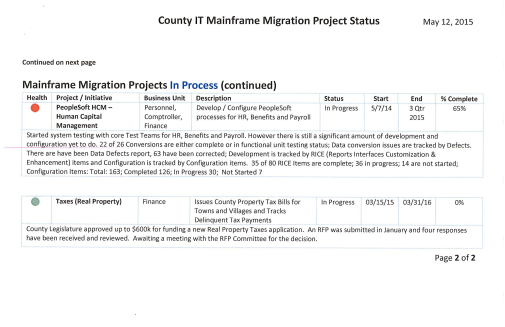
- √ items have been implemented and are off the mainframe
- Rewrite - rewrite and recode the application from the ground up; completed for everything with a checkmark
- Rehost - take the basic code program and run them up a new environment
- 3p - 3rd party, purchase program then implement and intergrade with other applications
- BOE - currently on hold, hope to get back to it later in the year
- C2 - biggest development effort, seeing light at the end of the tunnel; met with DA PROC committee to define project parameters, timeline and business rule, writing security rules is the last piece, all functionality in place; currently using the mainframe for C2, migration version in testing mode, trained 20+ agencies that use C2
- Clerk –IT has resource retention issue, only 1 developer knows the information, production issues of the day take over more often than not
In answer to Chair Rapp, Mr. Sexton said that internal staff is doing the work for the Clerk. Chair Rapp asked if this was holding things up. Mr. Sexton said that it was not. They know some legacy applications will remain on the mainframe longer than others, mainly taxes. They are going to need something to run this on until at least the first quarter of 2016. They are looking for smaller, less expensive environments, to keep things alive until they get everything off.
- Inmate –will implement in a couple weeks, big effort
- ESP Civil Service – older application, people apply for civil service positions online, tracks test results and certification; 3p solution, vendor active on project
- Health – CHM project discussed today, 2/3rd’s complete for signoff, 80% for development, much testing and certification to be done, project tracked by a number of things – counts listed in status update
Chair Rapp said that this was a lot of information. They have spent a lot of money and a lot of time and she did not get a phone call to say that this information was coming, much less get it in advance so that questions could be prepared. This is a problem, the information effects the day-to-day operations of the County and it is complicated to her. Mr. Sexton said that it was complicated for everyone. He will provide the information on a monthly basis via email. Chair Rapp said that it would allow them the opportunity to better manage this, now they are reactive, as they try to read the information and listen to him at the same time.
Mr. Knapp asked what the colors mean. Mr. Sexton said that green means that they are on target, yellow means minor delays, and red means significant delays. Mr. Knapp said that the red ones are some of the more complete projects. Mr. Sexton said that they had target dates that were earlier than what they are looking at now.
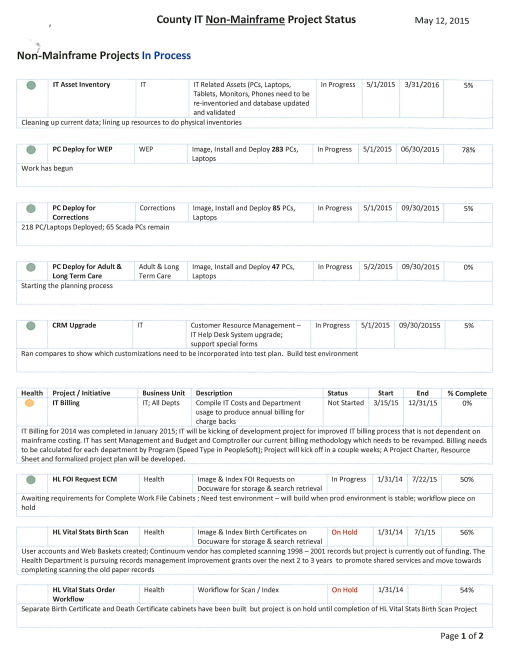
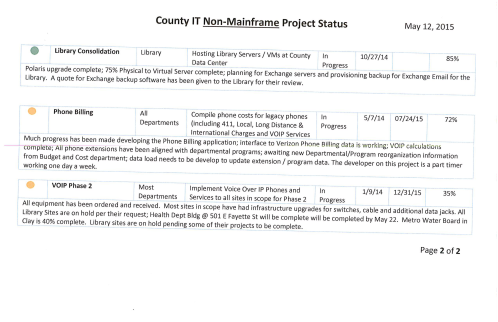
Mr. Knapp said that the mainframe will be done, once the items listed are taken care of. Mr. Sexton said that the only other item is called JRP. It is not an established project as they have not determined where it will land; host on smaller environment or rewrite. Mr. Knapp said that he would hate to have just one item sitting there. Chair Rapp said that everything should be wrapped up and off the mainframe by next March. Mr. Sexton said that was the plan.
Chair Rapp said that there were many computers that had not been purchased towards budget time and asked if they were all in place now. Mr. Sexton said that they are putting together the order for the 2015 budget. 2014 computers are nearly done, still working on Adult Long Term Care, WEP is almost done and Corrections just started. In answer to Chair Rapp, Mr. Sexton said that they should operate within budget for this year.
Mr. Fisher:
- County Executive trying to keep IT flat, if IT shifts priorities to put more money into certain programs, would like Legislature to understand
- Pleased with IT’s response to move from outdated technology without additional dollars, same appropriation as 2013 and 2014
c. INFORMATIONAL: New NY Broadband Program
- NYSAC had webinar presentation last week; have been working with City on broadband initiative, want high-speed internet available for all
- NYS has had big programs in place, prior to this year issued $70 million for broadband initiatives in various parts of the state; just approved $570 million to be funded for various projects, must bid on award, webinar provided information needed to be eligible for funding
 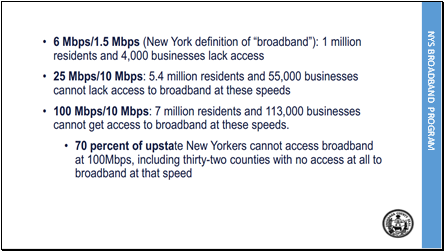
- Underserved and unserved areas of the state likely to get benefit first; 6 Mbps general speed from Time Warner, for comparison County has 100 Mbps speed
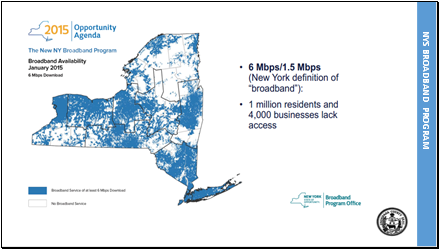 
- Onondaga County one of the best areas in the state in terms of service, some gaps and some only have 1 option
Mr. Plochocki said that according to the map Onondaga County looks good but there are areas in his, Mr. Knapp’s and Mr. Shepard’s district that do not have access.
- Not much funding near Onondaga County; funding depends on bids, need to get plan together for needs
Mr. Knapp said that Cayuga had a big project and to the north there was a project in the Phoenix area.
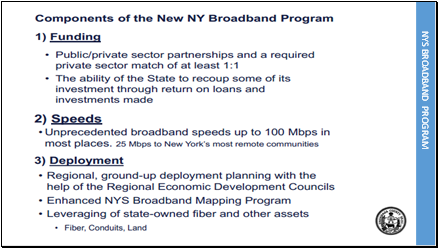 
Mr. Knapp:
- Historically Time Warner and Verizon have not been interested in participating in this
- New Channels, local company on Bridge St, very interested, handled Phoenix project, not sure who did Cayuga
Mr. Sexton:
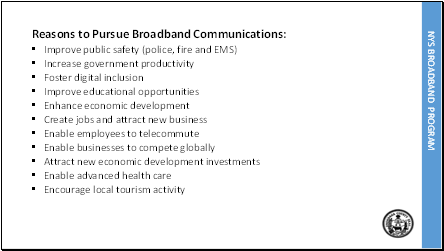 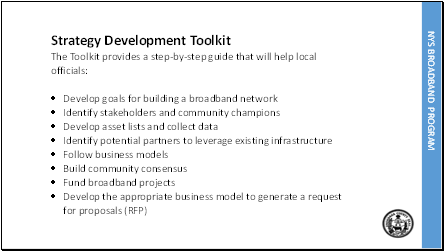
- City pushing ahead for Economic Development
Chair Rapp asked if the City was looking at a different pot of money to create mega speed throughout the City for Economic Development. Mr. Sexton said that he believes the City is going to go after the funding discussed here also.
Mr. Fisher:
- Since that the Mayor will try to take some of the $500 million competition and layer it on top of this; might be something the towns should do also
- For the towns OCM BOCES has down a good job getting broadband to the schools, may be things that could be build off from what they have already done
Mr. Knapp asked if there were big areas of the City that did not have broadband at all or was it just low speed. Dr. Chase said that the area around the inner city was not good. Mr. Sexton said that Time Warner was the one company available for most of the City, a virtual monopoly in many areas. If nothing else, they could bring other options, and hopefully lower costs and higher speed options. He would like to see all buildings that are a part of Onondaga County on high speed, at a reasonable cost; 1/3 of the buildings are on high speed fiber network connections. Chair McMahon said that part of the issue with the City is that they have a franchise agreement with Time Warner, they cannot do business with anyone else. When he was a councilor they looked at bringing in Verizon. Dr. Chase said that Verizon did not want to come in because they did not get paid. The area that is not well served, historically does not pay their bills and Verizon did not want to get involved.
 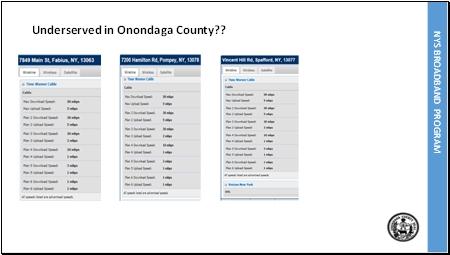
Chair Rapp asked if they needed to put together an RFP to provide service to outlying areas and parts of the City. Mr. Sexton said that they needed a business plan to discuss areas within the County. They need to understand who is suffering most, focus on that and then broaden it to make it countywide.
Chair Rapp suggested that Mr. Knapp take the lead on this. Mr. Knapp said that he, Mr. Shepard and Mr. Plochocki had already done a lot of work on this. Chairman McMahon said that they had passed a resolution on this topic before. Mr. Knapp said that it was basically memorializing the NYS to do this. At that time, they had a decent map that showed the areas that were not served or were underserved. He was looking forward to hearing what they need to do to apply, who they need to reach out to in the private sector, and if this is going be done countywide or by individual towns.
Chair Rapp said that she was wondering if the REDC group was going to put together a proposal for this. Mr. Knapp said that it seems foolish for individual towns to reinvent the wheel, one would think it would happen at the County or REDC level. Mr. Sexton said that the process to get information is consistent and there are big benefits to working together. The IT team can help wherever needed but they need representatives from each area to provide the knowledge needed to fill in the blanks. It is easier to award money to an organization that has a plan in place.
Mr. Fisher:
- NYSAC advised looking at this pot of money differently than the Economic Development grant funds (REDC)
- CFA process has 20% of the weight for other grant sources being voted on by REDC personnel, want them on your side to get high marks, other 80% of weighing criteria for $500M in new NY Broadband dollars is distinct from REDC funds
- Some larger counties have taken the lead, recipient towns don’t’ always have technical savvy, need private partner 1:1 match; towns need to understand what constituents are telling them, County GIS can help with maps, IT can help with technology, believe that towns and villages must apply for the grants themselves
Chair Rapp said that the Regional Planning Board could do this for the entire region and they have been successful getting grants. Mr. Fisher agreed. In answer to Chair Rapp, Mr. Sexton said that he did not have a due date for the applications. There is another seminar in June and he will forward information as it comes in.
- Legislators more aware of unserved areas; quick search of these 3 areas showed limited options
Chair Rapp said that New Channels was a viable alternative. Mr. Sexton said that he would send links for the full tool kit. Mr. Knapp said that he would put together a multi-town meeting. Mr. Sexton said that he would share the findings from the City plan as they are the same types of things that each town and/or village will need to do.
A motion was made by Chair Rapp, seconded by Mr. Knapp to approve item 4a. Passed unanimously; MOTION CARRIED.
5. SYRACUSE/ONONDAGA COUNTY PLANNING BOARD: William Fisher, Deputy County Executive
a. Confirming Appointment to the Syracuse/Onondaga County Planning Board
A motion was made by Mr. Knapp, seconded by Mr. Burtis to approve this item. Passed unanimously; MOTION CARRIED.
6. Establishing an Advisory Committee to Assist the Onondaga County Legislature in its Review of Comprehensive Master Plans for the Development of Onondaga County (Sponsored by Mr. McMahon)
Chair McMahon:
- 2012 County Executive put forward her ideas, not well received by the Legislature
- Legislation creates appointed advisory committee to review the different plans, i.e. Regional Planning Authority, County Executive and others; board will make recommendation to him, will put together a plan to vote on this year
- Legislator’s Shepard and Dougherty will be appointed to the board, will vet what has been done, don’t need to recreate the wheel, heard concerns from constituents about plans; Legislature’s job to set policy
Mr. Knapp said that this was a great idea. Chair Rapp said that there are pros and cons to all of this however, she recently road around Oneida Lake and much of it looks like Appalachia. Oneida Lake developed differently than Skaneateles or Cazenovia, as there has never been any strategic planning. It is a wasted opportunity.
A motion was made by Mr. Knapp, seconded by Mr. Burtis to approve this item.
Dr. Chase said that she thought each caucus should have three appointments to the board and the County Executive should have one. Chair McMahon said that it was an advisory committee to him therefore he comes up with the policy. Dr. Chase was welcome to put forward her own legislation.
Passed unanimously; MOTION CARRIED.
8. GREATER SYRACUSE PROPERTY DEVELOPMENT CORPORATION - LAND BANK:
a. Amending the 2015 County Budget to Make Money Available from Contingency for Use by the Greater Syracuse Property Development Corporation, and Providing for Agreements as may be Necessary Related to Such Use
Chairman McMahon:
-
Previously secured $500,000 in contingency; last year earmarked funds for specific areas, Land Bank asked for unrestricted funds to be used as leverage for other funding
-
Legislation proposes $300,000 unrestricted and $200,000 earmarked for non-tax delinquent bank owned vacant housing
-
$200,000 creates revolving fund to address issue; Land Bank will work with banks to acquire property, rehabilitate and sell to owner occupant, as funds come back in they go back into the fund and the process is repeated, highly effective
-
9 vacant properties in Village of Jordan, a lot for a small concentrated area, manageable goal to fix problem; identified 14 vacant houses over the winter in the Syracuse Valley area south of Seneca, real problem, most are bank owned and difficult to get; 40 vacant properties in Village of Baldwinsville, Mattydale has same problem
-
Down the road may need to fund this greater
Chair Rapp said she received a phone call from a Mattydale councilor who has identified vacant and abandoned houses as the number one problem in their community. It was disappointing to hear from the Land Bank that only three homes had been addressed in the County. This was not their intent and they need to figure out a better way to do this. The Onondaga Citizens Report speaks heavily to what is happening with housing stock and migration patterns in this County. It is pretty scary and unless they do something to get in front of this, they could all have problems.
In answer to Mr. Knapp, Ms. Wright said that the Land Bank was currently in the process of purchasing a home from a bank. It is a process to get through to them but once you do, they want to get these homes off their books also.
Mr. Knapp said that this is a problem in his district also, as the properties are not kept up. Chairman McMahon said that the longer they sit there, the more money it costs to rehabilitate them. Chair Rapp said that one home drags an entire neighborhood down.
Ms. Wright said that Home Headquarters has a lot of experience with this and they have been able to learn a lot from them. One challenge that they face is FHA mortgages, as they do not want to write these off. To get a short sale is extremely difficult
A motion was made by Mr. Liedka, seconded by Mr. Knapp to approve this item. Passed unanimously; MOTION CARRIED.
Chairman McMahon:
- 1st phase of Neighborhood Initiative has kicked off, geographic areas are Village of East Syracuse, Valley portion of the City, Strathmore, Village of Mattydale, a piece of the Village of North Syracuse and a small piece of Cicero, areas are eligible for 1% home improvement loans; will provide educational meetings in these areas
Ms. Wright said that last year there was one vote for removing the contingency and another vote for the contract. Chairman McMahon said that he thinks the contract has to be worked out on the County Executive side. Mr. Fisher said that last year there was contract with Management and Budget and the CFO oversaw it. Their inclination is to handle it the same way.
Chair Rapp:
- September 2015 Olympics of Lacrosse coming to Onondaga County, application made by The Onondaga Nation to secure World Olympics; 13 different countries including China, Czechoslovakia and Canada
- Nation put up $4 million to win the bid and is building an indoor box lacrosse stadium
- 3 week event with opening ceremonies on The Nation, final game at Carrier Dome, will have Festival of Nations, buffalo roast, under 19 and masters tournaments; anticipate 28,000 to attend final game
- Those attending The Onondaga Nation events can have passports stamped as visiting a foreign country
- 60 Minutes and Good Morning American doing a segment on this
Mr. Knapp noted that this was box lacrosse so it is different than the World games.
The meeting adjourned at 11:26 a.m.
Respectfully submitted,

KATHERINE M. FRENCH, Deputy Clerk
Onondaga County Legislature
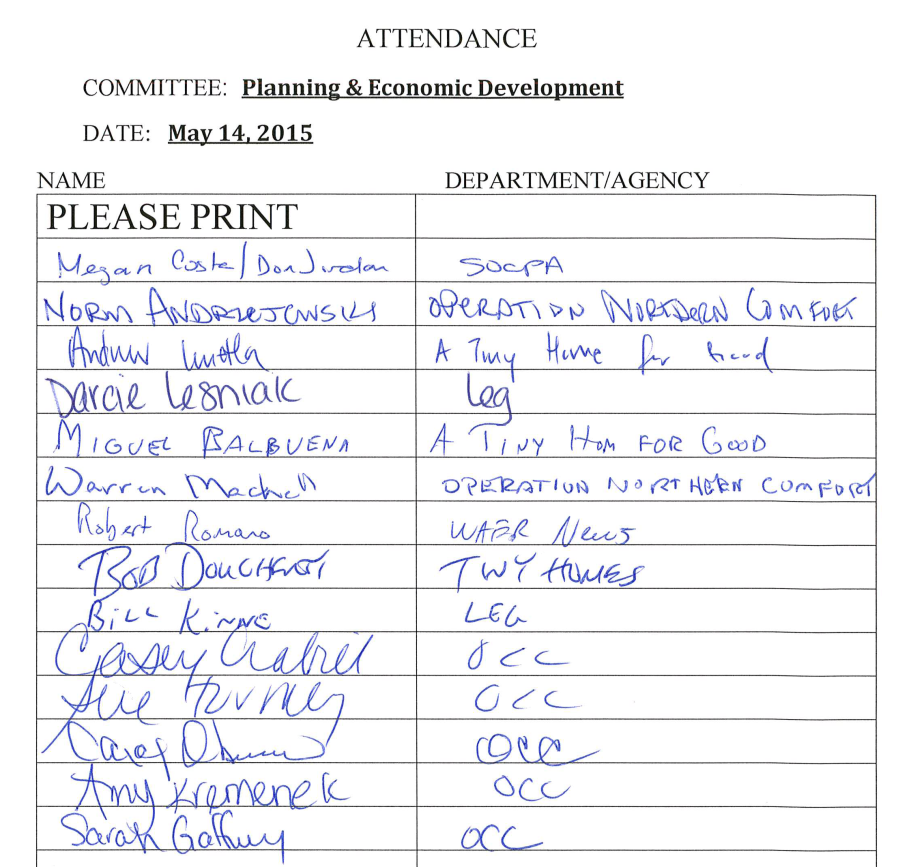
* * *
JOINT MEETING OF COUNTY FACILITIES AND WAYS AND MEANS COMMITTEES - MINUTES - MAY 14, 2015
Judith Tassone, Chair DAVID KNAPP, Chair
County Facilities Committee Ways & Means Committee
COUNTY FACILITIES MEMBERS PRESENT: Mrs. Tassone, Mrs. Rapp, Mr. Ryan, Mr. Shepard
ABSENT: Mr. Dougherty
WAYS & MEANS MEMBERS PRESENT: Mr. Knapp, Mr. Kilmartin, Mr. Jordan, Mr. May, Mr. Holmquist, Ms. Williams
ABSENT: Mrs. Ervin
ALSO PRESENT: Mr. Liedka, Mr. Burtis, Mr. Plochocki, Dr. Chase, see also attached list
Chairman Knapp called the meeting to order at 11:40 a.m. He pointed out that there are two items on the agenda: OCC’s operating budget and a capital request. He is not planning on calling for a vote on either item today; they will be marked as considered.
1. ONONDAGA COMMUNITY COLLEGE: Dr. Crabill, President
a. Adoption of Annual Budget for OCC for the Fiscal Year September 1, 2015 to August 31, 2016, and Authorizing the County Executive to Enter into Contracts with Other Governmental Units in Which Appropriations and Revenues are Approved by the Adoption of the 2016 Budget
b. A Resolution Authorizing the Reconstruction of Improvements to OCC Facilities, In and for the County of Onondaga, New York, at a Maximum Estimated Cost of $17,600,000, and Authorizing the Issuance of $8,800,000 Bonds of Said County to Pay Costs Thereof
A copy of the annual Report to the Community and a copy of a study, done every two years – return on investment for students, community and taxpayers:
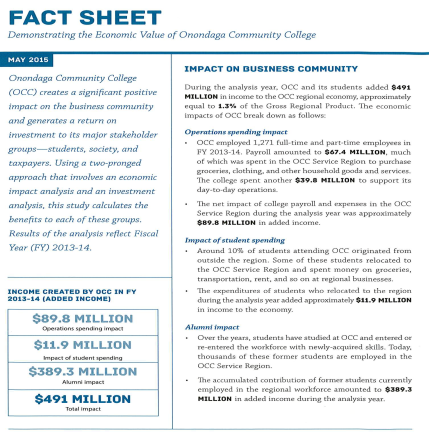
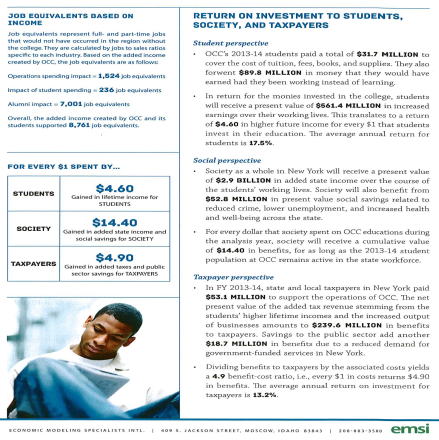
Dr. Crabill noted the following about the class of 2015
- First graduating class of the Nuclear Energy Technology Program-
- 13 have completed the program in 2 years; it is a tough program
- 11 already have jobs with a local nuclear plant; the other two have offers and transfer options
- Program started in collaboration with nuclear production business community – only 36 colleges in America have the program
- Draw for returning vets – can bring their technical knowledge into the program
- Oldest graduate is 74; a cancer survivor, professional communications – top student in the program
- Youngest graduate is 19 – graduating after only a year, had taken advantage of College Credit Now program while in high school; came to OCC with 36 credits completed; honor student; going on to Binghamton
Chair Knapp asked if OCC has agreements with all the high schools in the county. Dr. Crabill said that they do; they take the lead from the schools. Some offer more opportunities than others. CNS is quite involved; Fabius Pompey does something, but not as much. The programs that just do very basic are typically college English and college math. Some schools branch off into social sciences; things that aren’t part of the high school curriculum to provide some additional enrichment and variety.

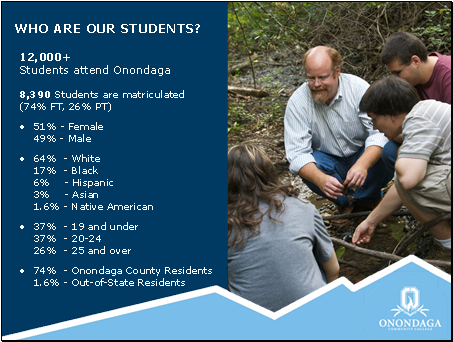
- Have a very large full-time population; different from many community colleges; a good predictor of success; challenging because they draw on services more.
- Younger than many other community colleges; adult population is small

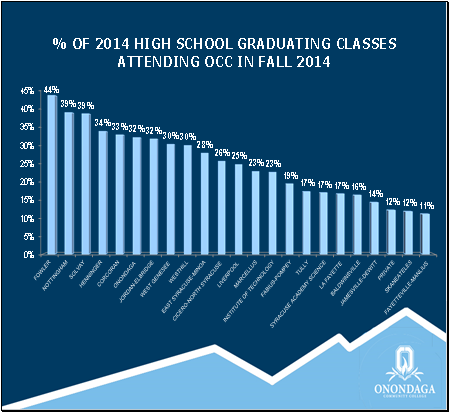
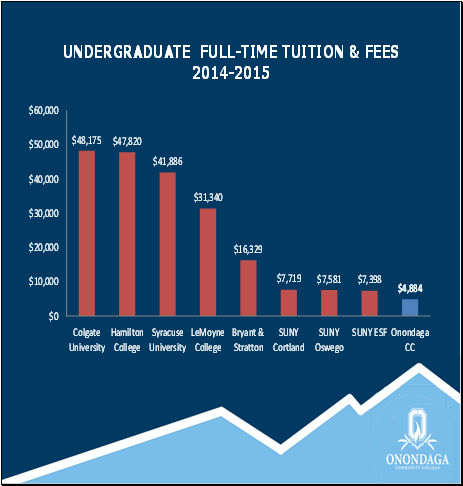
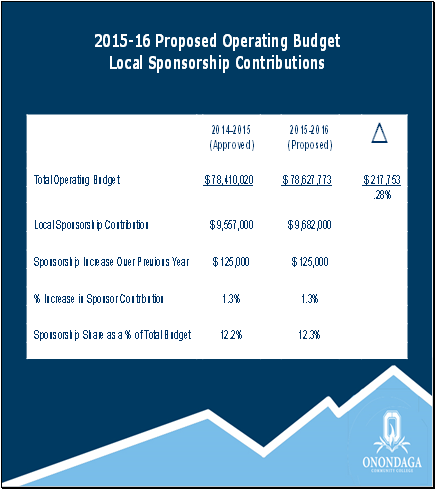
- To stay affordable--have to control costs to fullest extent possible
-
Don’t roll money forward and say it’s the starting point for next year’s budget - take a critical look at historical spending every year making sure annual appropriations are appropriate to the mission
- Cut significantly from all requests that came forward
- Board approved – total increase less than 1/3 of 1%
- Asking for $125,000 increase in sponsor share
- Tuition increase of $65/semester
- State contributes $100 more/FTE
-
Goal is to be frugal and predictable
Mr. May stated that he appreciated the opportunity to look at the budget early and congratulated OCC on their good work. He referenced the slides relating to the operating budget and capital requests, and suggested that having an executive overview which includes the ask, particularly on capital, would be helpful.
Dr. Crabill said that this budget allows sustention of all of the current programs, except respiratory care, which they have been phasing out for two years. The employment market was saturated, and the scope of that practice is changing so students are better served to move through the Upstate program.
Mrs. Rapp asked if there is an advanced manufacturing degree. Dr. Crabill said that they have a manufacturing technology degree and and advanced manufacturing certificate, which was built through MACNY and local companies. It is a hands on, one year, employment certificate. They are now doing stackable, one time, pieces of manufacturing that can be linked together. Companies are very supportive of it; lend the college people to help develop the program. Mrs. Rapp said that the biggest feedback from companies is that they have jobs, but don’t have the people with those skills.
Mr. Kilmartin asked what areas of study are most popular and growing related to the job market. Dr. Crabill said that students chose program where they have seen people do the job. Nursing remains very popular. Introduction to the Health Careers, will be included next semester. A lot of students want to work in health careers, but may not have the science necessary to become nurses straight away. They want to introduce students to the myriad of jobs available in the health field. Criminal justice remains incredibly popular. Nuclear Technology continues to be popular. A lot of students want to sign up for what they can work in. In answer to Mrs. Rapp, Dr. Crabill said that they can take 24 students in the live lab, but students go part time and full time, so they have to stagger. The goal is to get up to 48 in the program – run the live lab in the fall and spring and stagger them. Mrs. Rapp asked if there are enough job opportunities for them; with the one company hiring. Dr. Crabill said that there are other companies coming forward who are interested in hiring students with these skills. They are branching out beyond the production of nuclear technology to high-voltage applications to manufacturing facilities. The student can take the training; it is portable because they ultimately get a national license. The goal is to meet the local need first.
Mr. Ryan asked if any emerging industries or markets are foreseen, so that the college is growing, adapting, and being more marketable. Dr. Crabill said that their job is to make sure they get to it and deal with it while it’s still the next big thing and not the last big thing. She has staff all over the county getting into the right employer or innovation. There is a lot coming with the nano development in Utica. There have been deep conversations with SUNY IT on how they can do the seamless, 2+2 transfer – get the basics at OCC and move onto Utica (for example). There are lots of conversation about cyber security, which is a growing field; they have computer forensics. The best shot is to stay in connection with Regional Development, CenterState, and MACNY. Also, as the state level, SUNY tries to monitor some of it. The key is to be as flexible and nimble as they can be.
DACUM is a new process – puts employers in a room for 2 days and at the end of it, there is a curriculum. The curriculum comes right from the workforce needs; employers drive content in those programs.
Chair Knapp said that he is is excited about the Intro to Medical Technologies program, noting that the health care field is so broad. He referenced feedback from a meeting in Providence, RI, where the average age of medical laboratory technologists is 56 years old, and ten years ago it was 44. They are having difficulty finding people. Dr. Crabill said that they have a surgical technology program, one of the only ones, and Upstate would like them to graduate 10 times more. There isn’t the capacity locally to give them the kind of experiences they need. Students can take the skills in the beginning of that program, and can do the work in the sterilization units. There has been a great pipeline developed out of that path.
Mr. Jordan noted that tuition is going up $130/year/student and $14/credit hour, but tuition revenue is down by over $600,000. Dr. Crabill said that like most community colleges, they are seeing student retraction. High school graduation classes are getting smaller – lost about 500 students this year. In answer to Mr. Jordan, noting that no enrollment chart is included with the budget, Dr. Crabill said that one can be provided.
Mr. Jordan asked to be provided with the budget consolidated statements for the not for profits associated with OCC.
Mr. Ryan noted that we are not getting less of a percent of students wanting to go to OCC, there is less of a number to draw from. Dr. Crabill agreed, noting that nearly all across America the high school population is shrinking. Florida and Texas are the only two states where there is growth. There are declines in college attendance across the country. OCC looks at the market share – staying steady and being effective with sending districts. They look at retention of students to goal. In answer to Mr. Ryan, Dr. Crabill said that OCC has been on the small end of the decline compared to community colleges statewide– around 1.8%. Monroe has lost almost 6% of students.
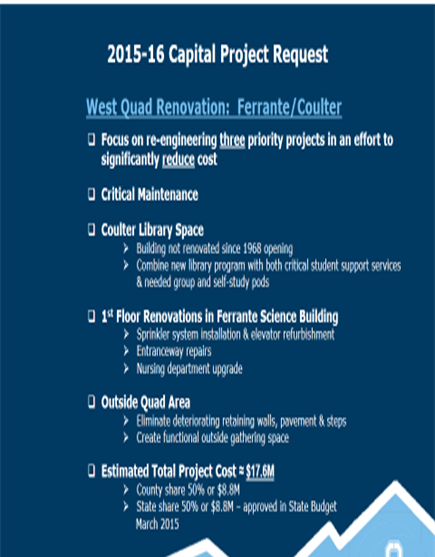
Dr. Crabill:
Coulter Library:
- Opened 6 months before man landed on the moon; has not been renovated since
-
Need of critical renovation for library program, critical support services, i.e. veterans services into current space – space that enables technology, project based work, work that happens in teams, meets needs of employers, prepares students for employment and transfer in competitive environment
-
Renovation designed to have 2 exterior exits (current library has 8), allowing half of the building to be locked off – won’t have to provide staff on 3 floors at times when library is open for quiet study
Ferrante Science Building:
- Needs new sprinkler system
- Repairs to entrance way
- Needs a roof
- Leveraged funds with nursing department - $200,000 from SUNY ESF 2020 Grant – partnership with ESF
- Able to do a systems for nursing, but not able to finish renovation of classrooms; which needs to be done
West Quad area:
- Pavers and brick – deteriorating, poorly graded, largely nonfunctional as an outdoor space
- In between Ferrante and Coulter – can create one large project and leverage funding to get all of the work done in one fell swoop
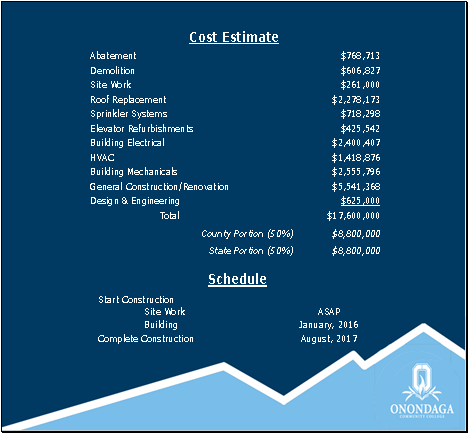
- Breakdown of work across all three areas that are part of the project
- $17.6 million total; Grateful to Sen. DeFrancisco’s support - NYS portion secured - $8.8 million, once there is a match from the county
Mr. Jordan asked for a breakdown of each element of the overall project. Dr. Crabill said that it hasn’t been broke out by building, but has it broken out by activity. Mr. Jordan would like to see a breakdown of each project; Dr. Crabill indicated that it can be provided.
Mr. Kilmartin encouraged people to take a look at what is being proposed. He pointed out the common quad area where the buildings come together -- there is convergence of a lot of walkways on campus. A lot of concrete, pavement, pavers have been there for years – can see a lot of cracking and patching that has gone on. There are many levels, a mishmash of walkways and pathways that look like are in need of substantial repair. Chairman Knapp agreed.
Dr. Crabill noted that the inefficient use in the Coulter Building, without being able to lock off part of it, limits the ability to have it open and available in the evening. The front part, where there are services, i.e. students with disabilities and veterans, is really hard to make any sense out of it. It hasn’t grown, it has developed over time into a bit of a mishmash. A full renovation would allow making those services more efficient, effective, and obvious.
Chairman Knapp said that he noticed that there aren’t any outlets around the library. The few areas where there are ducted tape power strips are very crowded, and the others are deserted.
Mr. Kilmartin noted that part of the renovation is for some of the offices – consolidating some and taking some out. The area dedicated to veterans is very small – no bigger than a large closet. Dr. Crabill said that those students, probably more than any other students, need a space to retreat to. A lot of them are dealing with stress issues. If around 12,000 people in an active space, it can be less than productive. It is an area that is included in the service development
Dr. Crabill said that it is important to note that they really changed their thinking on this project. The original plan took out a staircase, moved the elevator, re-plumbed the building, moved the bathrooms, knocked through brick, and knocked out some windows. All of that was taken out of the plan. It is a building, and functions as a building. They questioned what they needed to do to live in the building in a 21st century way. The things that they boiled it down to are fundamentally necessary for the building to function now and in the future.
Mr. May said that he really appreciates that thinking; it grounds everyone and the purpose of the school, why it exits and why it fits. He pointed out that the infrastructure is needed to support the new way to learn, study and produce in that environment.
Mr. Holmquist stated that he appreciates Dr. Crabill’s approach on both the capital and operating budgets – feels she has done an outstanding job. The communication with the legislature, illustrates all of the other great things. Dr. Crabill said that it is a wonderful school; the county has made a tremendous investment. It has a super history and great reputation. When OCC students apply to a receiving institution, they get a really good look. Mr. Holmquist noted that he feels everything being proposed is a need and very well thought out.
Mr. Jordan referred to transfer rates being down significantly. He noted that his stepson’s credits did not transfer to the University of Tampa from OCC. Dr. Crabill was surprised, as they don’t really ever hear of that. She said there is 100% reciprocity in the SUNY system; there is no trouble with SU, Cornell, LeMoyne, St. John Fisher, RIT, and hasn’t heard of any difficulty outside of the area. Sometimes they need to assist students with the argument or provide additional information, i.e. a syllabus, for the credits to transfer. Mr. Kilmartin noted that schools would have incentive not to take credits.
Mr. Ryan asked about retainment – the goal to get people there and keep them. Dr. Crabill said that they are flat with retention. For for students who come college prepared, the retention rate is 90%. For students who come in and are not quite ready with English, reading or math, the retention rate is 65%-68%. The goal is to get that group into the high 80’s. It is felt that it is achievable through some of the reprogramming that has been done in math. There is a national movement for kids who aren’t going into math and science, to move them away from algebra and into statistics. Most other fields rely on the ability to think statistically or in terms of probability. The Carnegie Foundation has supported that effort. She noted that OCC was accepting into Achieving the Dream, a national network of colleges that work together on increasing retention. There are about 230 community colleges in the network, which they can borrow strategies from. They have experts in various English, reading, and math fields that they send around to help revise policies and practices.
Mr. Ryan referred to the capital improvement plan. With the bid specs going out, there is an opportunity with the building going on. Health and nuclear technology isn’t for everybody – need to develop a work force and Central New York has construction jobs. Preparing the next generation for people who build things is a good thing. He proposed adding some apprenticeship language to this type of work – abatement, demolishing – general laborers, roofing, HVAC technology, sprinkler systems, general contracting, elevator mechanics, etc. It is an opportunity going on with the mindset of higher education and vocational training. We can appropriate $8.8 million to build a first class facility, while at the same time teach people. For the record, he would like to see this thought of and get some type of apprenticeship language built into the capital improvement proposals.
Chairman Knapp asked if it would have to be part of the specs that there would have to “X” amount of apprenticeship slots. Mr. Ryan did not know – if it could be put out to bid with a stipulation for, i.e. the roofing company -- do they have apprenticeship language; do they have an apprenticeship training program. He doesn’t know about conflicts with the low-bid process – doesn’t want to sell ourselves short. He doesn’t want a layer of added expense; wants to come in on time and under budget. In answer to Mr. Ryan, Mrs. Berger said that they are still looking at it.
Mrs. Rapp said that there may be workforce development funding available through the IDA.
Mr. Ryan said that he it be separate and distinct from what may be categorized a project labor agreement – can’t do that here – thinks it would be outside of the realms of our authority.
Mr. Kilmartin asked about the timeline and projected completion dates. Dr. Crabill said that the goal is to get it going as soon as possible because: 1. the quad work is outside; 2. can’t close the library while doing the project, so there is very clear staging. They want to get as much done in this summer and next. They are looking for completion by August 2017.
Mr. May commented on the athletic success of the college. He referred to the baseball/softball complex and one of the things promised in the proposal a few years ago, was community access. First hand he can say that not only has OCC been accommodating, but cooperative. The opportunities have been tremendous for teams and programs to use the facility. When it is a paid event, the pricing is very reasonable and within reach of all of the districts that need that kind of facility. It has been a great experience for the young athletes. The follow-through is noted and appreciated.
Dr. Crabill said that she has never been at an institution with such good athletic facilities. They are careful with their affiliates. Each affiliate is responsible to her to make sure that there is a funded reserve for the replacement of equipment and turf; replacement of roofs and mattresses in the case of housing. Those costs will never come back on the college. They were set up to take care of it on the long term. The quality investment was made upfront, their job is to make sure it sustains.
Chair Knapp asked what the percentage is of how many kids graduate on 2 years vs. 3. Dr. Crabill said that she will provide it. It is tracked at 2, 3, and 6 -- 2 is the original design; 3 is the Federal timeframe; 6 is the national community college timeframe.
Chair Knapp asked if there are any thoughts about expanded on campus dormitories. Dr. Crabill said that they are full; have been at 100% capacity since opened; there is a waiting list every fall. This year they started moving the academic programs into the residence programs, creating living-learning communities. There are programs and people in the same field of study to try to manage some of the challenges. The entire residence population is under the age of 19, and they are away from home for the first time. It has worked well – are expanding it from 4 groups (Healthy Living, Green Living, American Politics, Music) to 11 for next year. If it proves out like she thinks it will, then it might be time to think about creating more space for students.
Chair Knapp echoes what Mr. Holmquist said, noting that he loved the student-centered approach that has been developed the last few years. He complimented Dr. Crabill, Mrs. Tormey, and the OCC staff for being responsive throughout the years.
The meeting was adjourned at 12:40 p.m.
Respectfully submitted,

DEBORAH L. MATURO, Clerk
Onondaga County Legislature
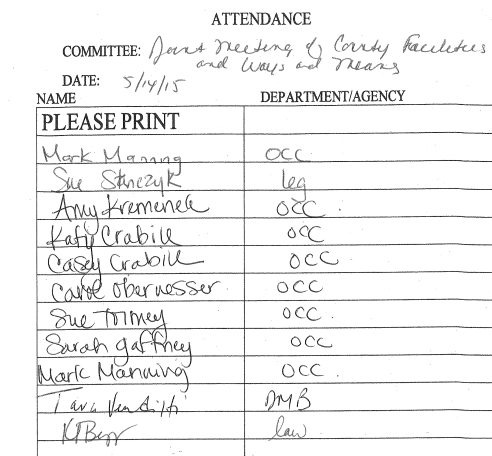
* * *
HEALTH COMMITTEE MINUTES - MAY 21, 2015
DANNY J. LIEDKA, CHAIRMAN
MEMBERS PRESENT : Mrs. Tassone, Mr. Burtis, Dr. Chase, 1Ms. Williams
ALSO ATTENDING: Chair McMahon, Mr. Kilmartin and see attached list
Chairman Liedka called the meeting to order at 9:35 a.m.
A motion was made by Dr. Chase, seconded by Mr. Burtis, to waive the reading of the proceedings from the previous committee minutes. MOTION CARRIED. A motion was made by Dr. Chase, seconded by Mrs.Tassone, to approve the minutes of the proceedings of the previous committee. MOTION CARRIED.
1. HEALTH DEPARTMENT: Indu Gupta, MD, MPH, MA, FACP, Commissioner; Michelle Mignano, Deputy Commissioner
Chair Liedka said the agenda would be taken out of order.
b. Providing for Personnel Changes within the Health Department and Authorizing placement at Advanced Steps for Newly-Hired Employees in the Medical Examiner’s Office
Ms. Mignano:
- Introduced Lisa Letteney as the new Director of Environment
- Request creating Sanitarian 4 position
1Ms. Williams arrived at the meeting.
-
Correctly aligns duties, same grade, no additional funds, looked at bulk of work required, needed for Environmental Health – food, animal disease and vector control; won’t fill Public Health Engineer 4 position
-
Requesting advance step hire for all MD titles and Toxicologist in ME’s office; highly skilled field, challenging to recruit under civil service guidelines, won’t need to request advance each time, have been here 5 of last 7 months
In answer to Dr. Chase, Ms. Mignano said that they would recruit from within for the Sanitarian 4 position.
A motion was made by Ms. Williams, seconded by Dr. Chase, to approve this item. Passed unanimously; MOTION CARRIED.
c. Authorizing Payment from the 2015 County Budget up to a Maximum Amount of $3,500 for Travel Expenses for the Position of Deputy Medical Examiner ($3,500)
d. A Local Law Authorizing Payment Out of the 2015 County Budget for the Relocation of the Deputy Medical Examiner for the Medical Examiner’s Office in the Center for Forensic Sciences up to a Maximum Amount of $2,000 ($2,000)
e. A Local Law Authorizing Payments for Certain Expenses in Connection with Recruiting for Positions within the Medical Examiner’s Office in the Center for Forensic Sciences
- Items b, c, & d are a collection of options to consider, always ask for travel and relocation expenses when recruiting for these positions, funds needed for recruitment, had a number of vacancies, have requested funds each time as with b & c, d would allow $1,500 for travel expenses and $2,000 for relocation, won’t have to keep coming back, will be happy to report back what they spend
In answer to Ms. Williams, Ms. Mignano said there will be two vacant positions in June.
Dr. Chase asked if they figured travel and training into their budget. Ms. Mignano said that they budget where they think they will be. They have a little room for travel and training as they are fiscally minded. Ms. Smiley said they may have to tweak a few lines at the end of the year.
Chair Liedka said that this was an either or vote for item b and c or d changing the charter to deal with all MEO positions.
A motion was made by Mrs. Tassone , seconded by Ms. Williams to approve item d. Passed unanimously; MOTION CARRIED.
Chair Liedka said there was a correction. The items discussed were actually c, d and e. They approved item d, which should have been item e. Ms. Berger said that this would be fine as long as everyone was in agreement
A motion was made by Ms. Williams, seconded by Mrs. Tassone to replace the approval of item 1d with the approval of item 1e. Passed unanimously; MOTION CARRIED.
f. 2015 Health Transfer Resolution ($235,000)
- Funds for contract pathology services through year end; recently recruited Dr. Clark, still have two vacancies
- Deputy Medical Examiner Dr. Knight has taken another job at Washoe County in Reno, NV
- Funds to cover 15 days a month over 6 months, average cost of $2,600 per day
Dr. Stoppacher explained that there are approximately 500-600 pathologists for around 1,000 jobs nationwide. New forensic pathology fellows finish in June and the prime recruitment is December-March. They will continue to recruit for our positions by targeting pathologists currently practicing, but don't reasonably expect to be able to fill both positions before the end of the year.
Dr. Chase asked if there was a possibility of starting a fellowship with the Upstate’s pathology program. Dr. Stoppacher said that they are in a catch 22 situation. Once they are full staffed they can try to get a fellowship, which would be a huge benefit as they would presumably have more constant trainees.
A motion was made by Ms. Williams, seconded by Dr. Chase to approve this item. Passed unanimously; MOTION CARRIED.
3. Requesting New York State to Take Such Action as Necessary to Criminalize the Sale, Use, and Possession of Synthetic Drugs, And Memorializing Support for the Enactment of Assembly Bill A.04175
Dr. Gupta introduced Michelle Caliva as the Administrative Director of Poison Control.
Chair Liedka:
- Memorializing resolution to address synthetic marijuana; has had staggering impact over last couple months in Onondaga County
- Wanted to make law more penal, County unable to levy penalty greater than a misdemeanor; requesting NYS to pass the law with expediency - criminalize sale, possession and use
Ms. Caliva:
- Since 2012 saw decline in ER synthetic cases, April 15 through today perceptive increase, volume off the charts, over 200 calls; primarily Onondaga County and NYC
- Poison Center covers 54 counties, Onondaga County is the hot bed, not seeing in other counties
- Many coming into Upstate, St. Joe’s and Crouse saying they got a bad batch, have been using for months, weeks or years; are hospitalized with agitation and hypertension or respiratory distress, very odd mix - bad batch or chemical configuration has been tweaked
Mr. Liedka:
- Substance comes from China, mix with acetone via cement mixers to make batches
Ms. Caliva:
- Spike is the current hot name in Syracuse; abused the same way as marijuana but is chemically different
- False since of security among abusers, cellophane packaging looks safer than baggie; no regulation, different from package to package
Dr. Gupta:
- Designer drugs, use same active ingredient, change chemical structure
- Creates problems for physicians dealing with ER cases, can’t be tested, no supported treatment; significant Public Health problem
In answer to Dr. Chase, Chair Liedka said that Onondaga County has already levied the maximum penalty. They are asking Albany legislators to pass a state law. They have done a lot of research on this and this is as much as they can do.
A motion was made by Mr. Burtis, seconded by Dr. Chase to approve this item. Passed unanimously; MOTION CARRIED.
2. INFORMATIONAL: Protecting Infants and Children from Harmful Health Effects of Unnecessary Exposure to Toxic Chemicals
Chair Liedka introduced Nader Maroun, Syracuse Common Councilor, adding that he was partnering with him on the next few topics as they are not isolated to one constituency.
Chair Liedka said that there has been a lot in the media about toxic chemicals in toys and Albany County has passed a law. Mr. Maroun said that he would leave some literature on the Albany law as well as the state law (On file with Clerk). Albany County has one year to try and implement enforcement of the law.
Dr. Gupta:
- Looked at Albany County law and state laws from Maine and Washington
- Albany County law has weak points: doesn’t state level associated with chemicals, puts burden on retailer not manufacturers
- Maine and Washington state laws had 2 prong enforcement, manufacturer had to disclose chemicals and retailers couldn’t sell products, burden goes back to the retailer; travel a big problem, consumers could still purchase items outside the area
- Recommend state comprehensive plan instead of local law, NYS Health law currently in the works
- Onondaga County has a robust Public Health program - work with Environmental Health, health promotion, lead management, child screening and lead education; acting on prevention side countywide
Mr. Maroun:
- Asks that they consider the Albany County law and how they might proceed as a City/County
- Assembly passed toxic toys law, has been held up in the Senate for 2 years; if state is not going forward, ask that the County consider passing a law
Dr. Chase asked the reason for the delay. Mr. Maroun said that he did not know. Chair Liedka said that as a layperson it seems that this would be an extreme undertaking to test all the toys. Ms. Williams asked who would be the keeper of the action and monitor it. Dr. Gupta said that this is why the manufacturer has to be made responsible. Mr. Maroun said that enforcement is the issue. Chair Liedka said that this seems to be bigger than a state issue.
Mr. Maroun:
- National problem that needs to be dealt with, similar to flooring problem from Lumber Liquidators
- Children exposed to a lot of lead, asbestos and mold in older homes; toxic toys is something that needs to be addressed, informational today, appreciates the opportunity
Dr. Gupta reassured everyone that the health department was doing lead testing for the pediatric population that was very strict, with all pediatricians well informed. They continue to work with everyone, including the City, on enforcement. It is a very important Public Health issue and they are doing their best to keep the community safe.
Mr. Maroun said that the Common Council is willing to do whatever they can, in concert with the County Legislature, on this issue.
Mr. Burtis said that perhaps they need cases to quantify that children are being hurt from toxic chemicals. Dr. Gupta said that the Health department monitors the number of lead poisoning cases and does case management along with a consultant from Upstate. There are issues and they continue to work on this through home inspection and working with pediatricians.
Mr. Burtis said that perhaps they need to heighten the awareness of toxic toys to the level of lead. Dr. Gupta said that it would be difficult to pin point where the lead poison came from, as there are a lot of older homes. It would have to be a well-designed study to get correct data.
Mr. Maroun suggested that each person contact the Senate to see where the bill is headed and asked that the Health department check with their colleagues in Albany. Other NYS counties are also looking to pursue this because of the delay in the Senate. Congressman Katko could assist them on the national level.
a. Informational: Lyme Disease - Dr. Gupta
Dr. Gupta presented the following:
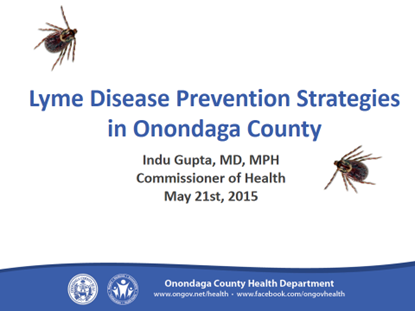 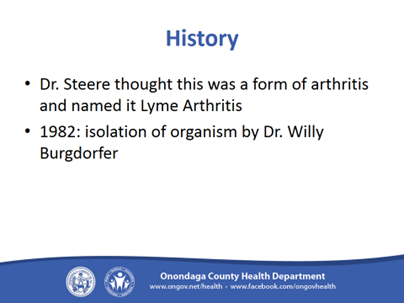
- May designated Lyme Disease Awareness Month, reminder that tick season is here
- Prevention strategy most important message from today - reduce exposure to tick bite, best defense against getting Lyme disease
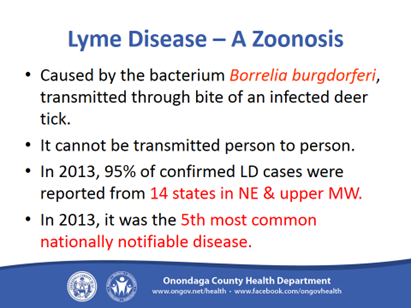
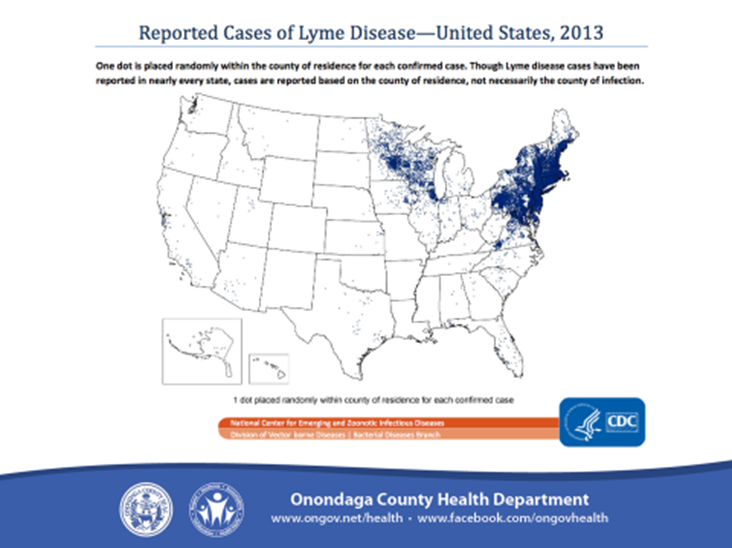
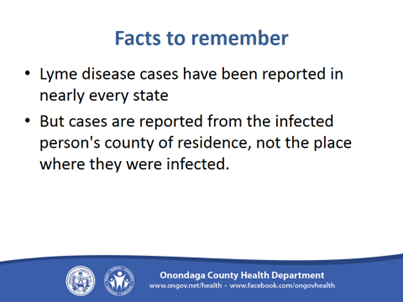 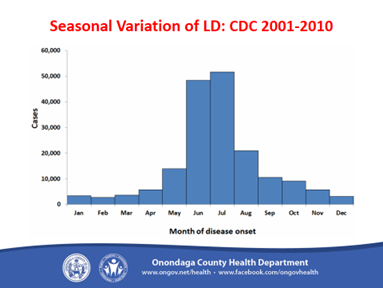
- Important to remember cases are reported from the infected person’s county, not from the location in which they were infected
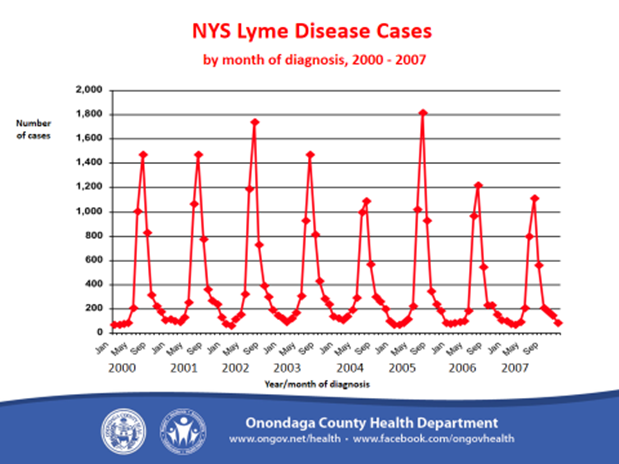
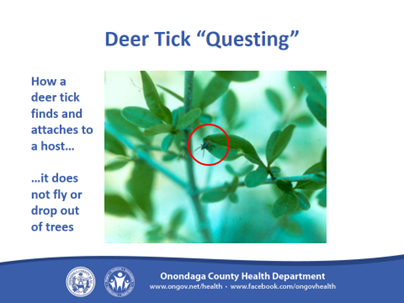 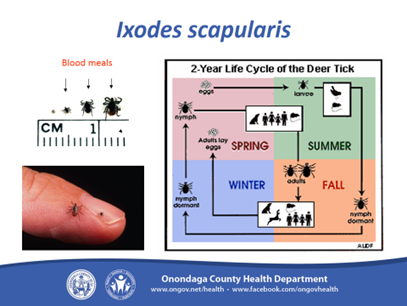
- Must have contact to have tick attach to skin, i.e. skin brushes against grass
-
Nymphs very tiny, difficult to see in skin, have to be very good about checking, prevention message is very important, spring and summer see mainly nymphs, cooler months see more adult ticks, easier to identify as they are larger
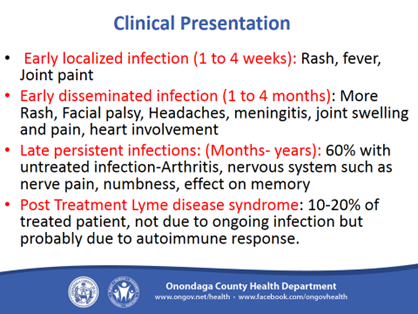
Chair Liedka asked if a person would have all three systems in 1 to 4 weeks. Dr. Gupta said that a person may have just one. The person may have just have the rash, then note a tick on their skin, removed it and then start to feel the fever. This is something they would want the person to communicate with their provider. The rash appears in 3-30 days and takes several days to weeks to disappear. It leaves a very classic impression. Left untreated it spreads into the system and there are neurological complications.
- Long term antibiotic treatment not recommended for post treatment
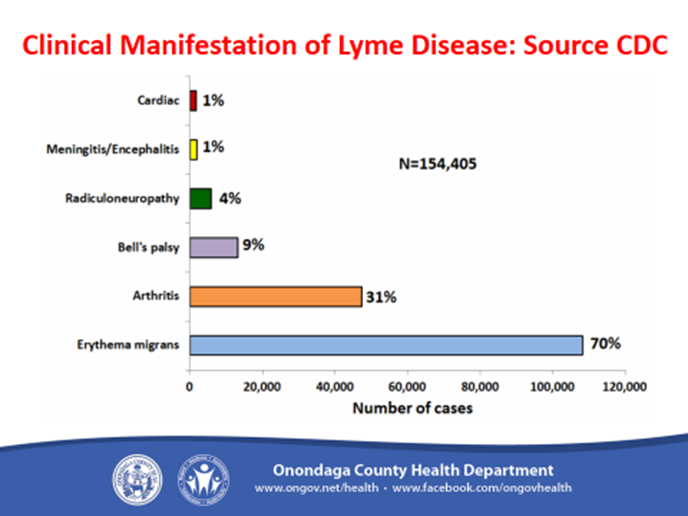
 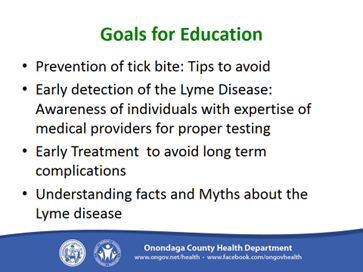
- Photo of classic rash in the process of fading away; could have more than one rash
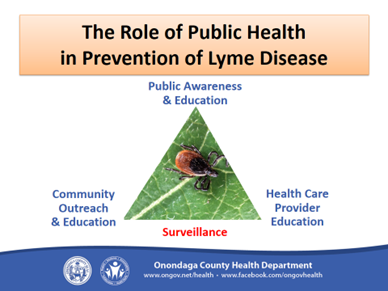 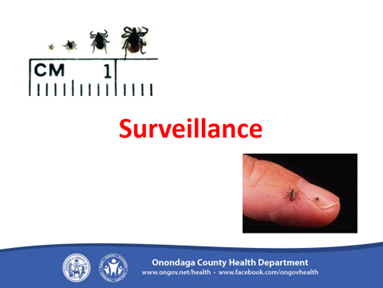
- Surveillance is data collection, used for multi-pronged approach, all 3 complement each other
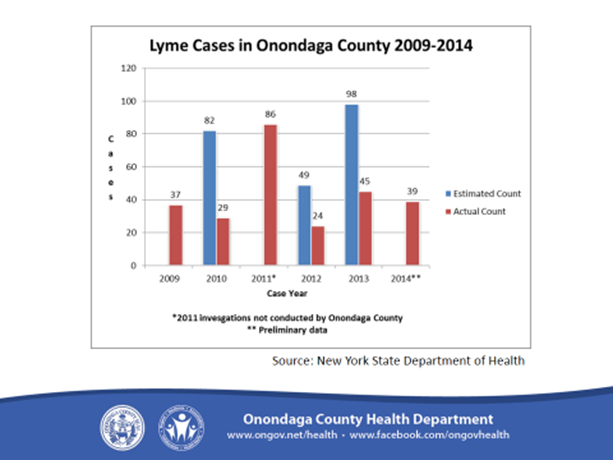
-
Not many cases prior to 2008, disease moving westward, much discussion in CA, have some cases there
-
County can’t investigate large case numbers, NYS Health dept. took over investigations, 20% of the cases are given back to Onondaga County for investigation, Lyme disease cases are complex, can be difficult at times, clinician must confirm Lyme disease based on their clinical findings, may or may not need lab testing, lab testing alone cannot confirm Lyme disease
-
Don’t recommend Lyme disease testing for someone with symptoms without exposure; case definition important, if someone has long-term arthritis and provider did a test for Lyme disease, may be called Lyme case but must question if it is truly Lyme disease, testing must be done in context of exposure
- Lyme cases does not confirm Lyme disease; Onondaga County now considered epidemic county
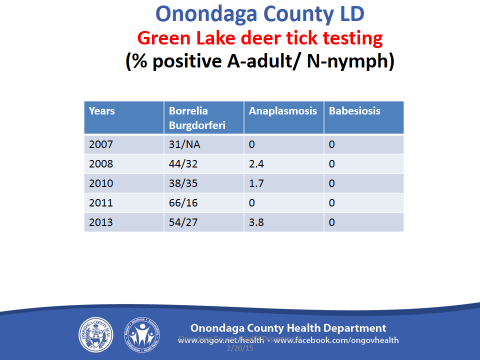
- Anaplasmosis and babesiosis are other tick-borne diseases; data for 2015 about the same, 55% of ticks are positive
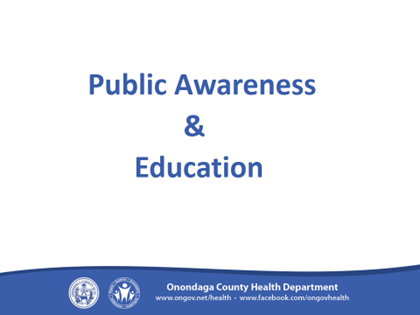 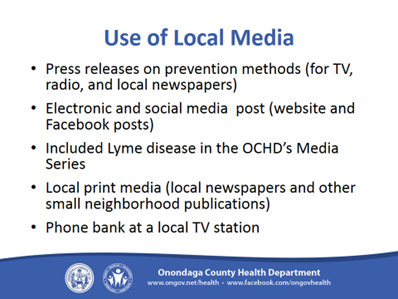
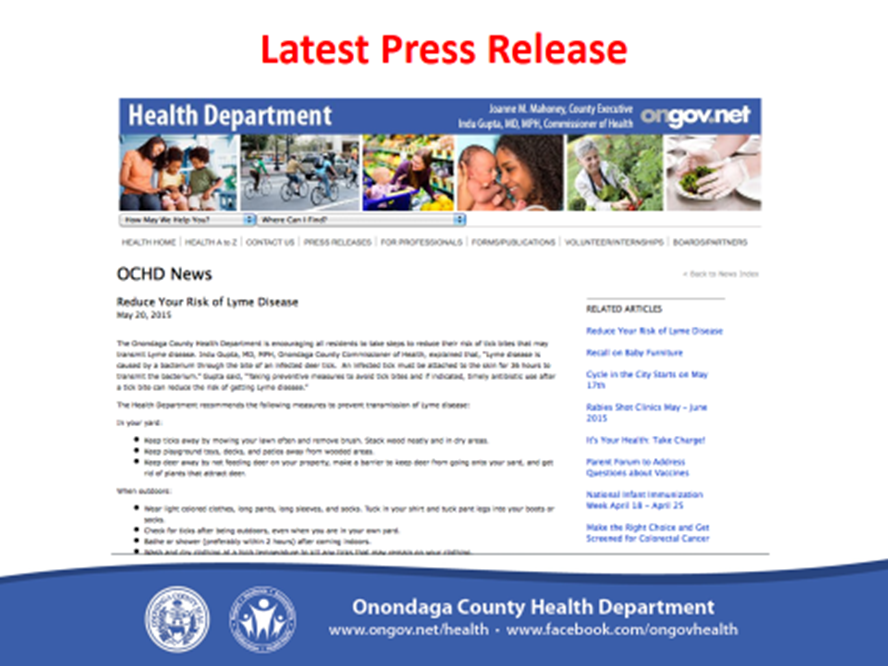
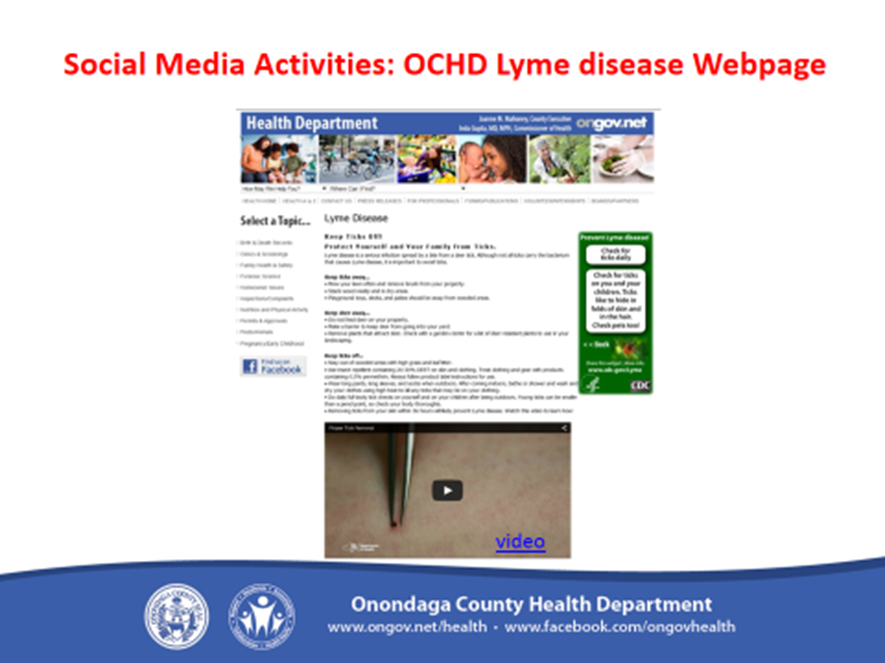
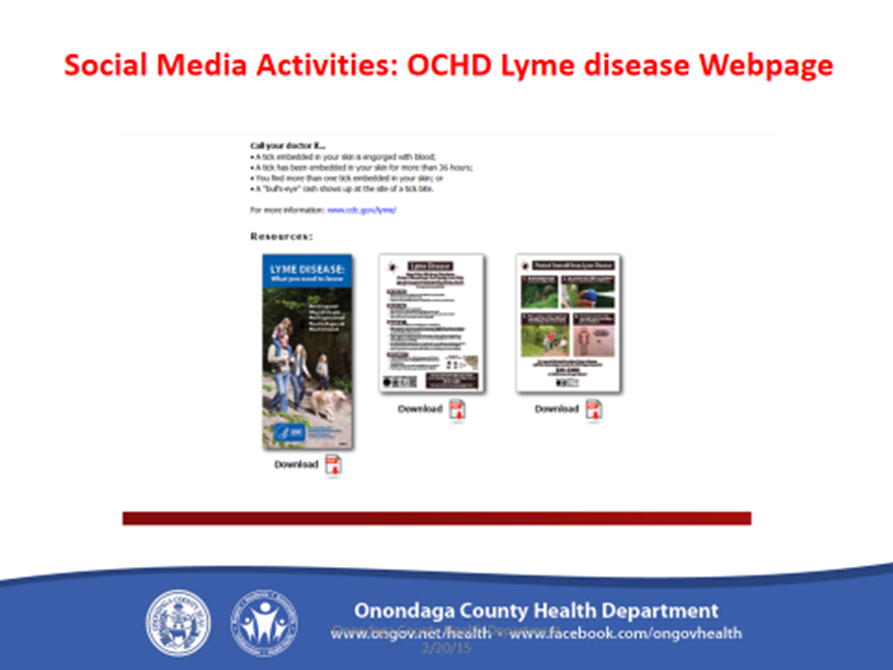
- Encourage everyone to download the information and read it
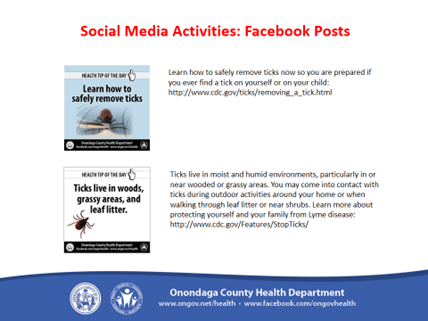 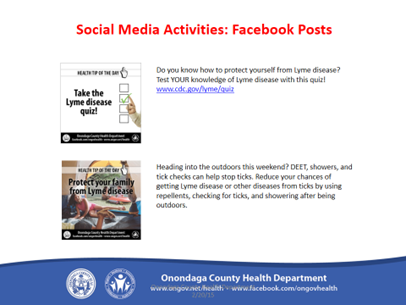
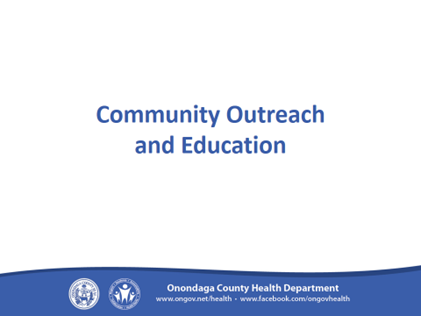 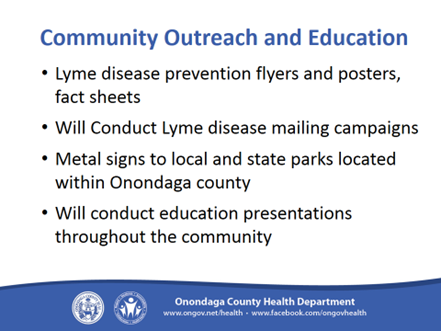
- Community outreach in the planning stage for 2015, looking to get more signs from the CDC, as well as NYS Dept. of Health
 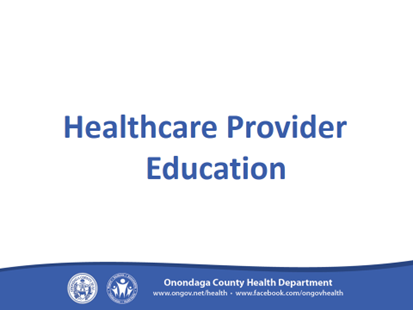
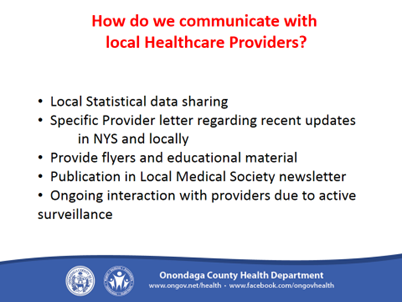
-
Member of the Onondaga Medical Society, discussed this topic a few days ago, reminder in newsletter, provide details about testing and pitfalls to avoid, often a complex disease; Public Health departments are very active with providers, just a phone call away, a very active partnership
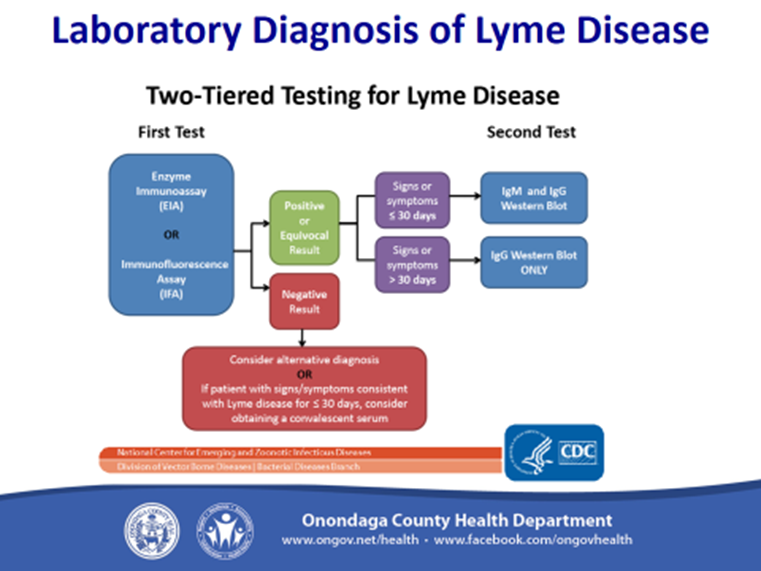
-
Very confusing if provider does not order correct testing, positive result does not mean a person has Lyme disease, IgG means the person had exposure, IgM means actively bitten person - want to treat
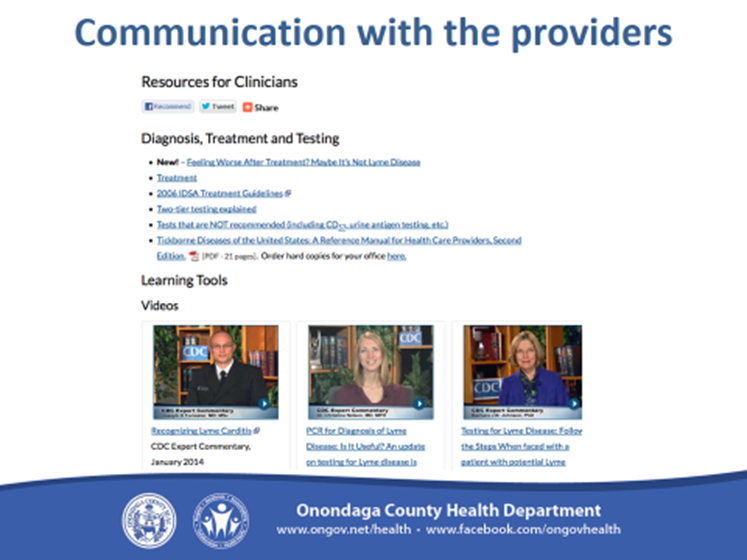
-
Attended and spoke at CDC sponsored Lyme disease conference in Albany, every county was represented, all learning from each other, active partnership with the state and CDC
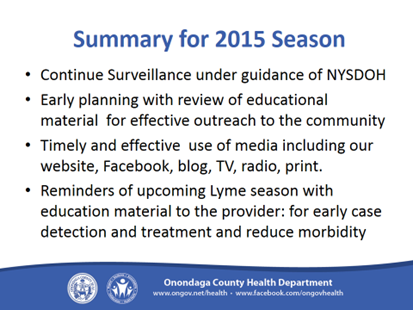 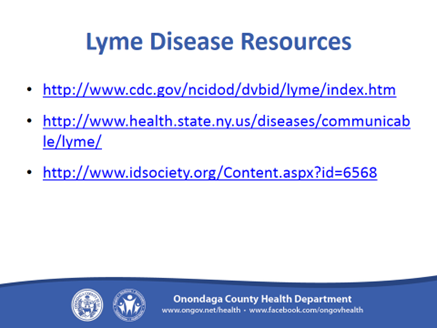
Chair Liedka said that David Skeval from Cornell Cooperative Extension, Brian Underwood and Melissa Fierke from ESF were present and he wanted to broaden the discussion to talk about the deer population.
Chair Liedka said that lowering the population is not an easy conversation but is the solution. He has heard advocates for deer inoculation and wants to know the costs and what the impact on the ecosystem will be, if the deer population keeps growing.
Mr. Skeval:
-
Studies completed in CT and IN show a positive correlation between deer density, tick density and incidents of Lyme disease; question becomes how to influence any one element - looking to lower cases of Lyme disease in people for this discussion
-
25 year career as a forester, initial concern was the impact on forests, as the deer index rises they can stop the forest from regenerating, must use extraordinary means including deer exclosure fencing
-
Cornell and Paul Curtis have been working with the urban/suburban environment and tired different methodologies of management; deer have been caught and sterilized, method proven to stabilize population at best, combined sterilization with deer harvesting to lower population, estimated cost of $5,000 per deer for sterilization, first must capture, use netting, then tranquilize and inoculate, if deer survives the processes
-
Studies show fewer ticks, less incidents of Lyme disease between ticks, lowers the bacteria in the reservoir; to decrease tick population need to get down to 6 deer per square mile, for density comparison the heavy populated area from Syracuse University to the Town of DeWitt up towards LeMoyne University probably has areas with 100 deer per square mile
Mr. Underwood said that studies have shown that over the lifetime of an animal, sterilization is within the ballpark. Chairman McMahon said that sterilization makes no economic since for the County, from a standpoint of resources. The Mayor has already spoken, saying they have no money for this. Sterilizing 10 deer is not going to move the needle.
Chairman McMahon asked if Dr. Gupta tracked zip codes for where they see Lyme disease. The question is where within the County do they see the problem, what strategies do they have to address the problem and what is the most efficient way to address it with the resources they may or may not have. Dr. Gupta said that they could track the zip code but they only get a certain percentage of the cases. . As a clinician she suggests prevention as the best strategy. A zip code is not going to give them the full picture. It is a countywide problem. They test at Green Lakes but that does not mean that other areas don’t also have positive ticks.
Mr. McMahon said that in Green Lakes Park they may be able to test and know that there are ticks with Lyme disease but the likelihood of that correlating into individuals who get Lyme disease at Green Lakes is probably much less than a neighborhood that has a high density of deer. If there is a city neighborhood bordering green space, the deer are going through back yards, it is very easy to spread in a small density area. He asked if it was important to try to deal with that deer population first. Dr. Gupta said that humans get the disease anytime there is brushing or contact with grass that has the tick.
Ms. Fierke presented the following:
- ESF recently received grant, provided handout (On file with Clerk)
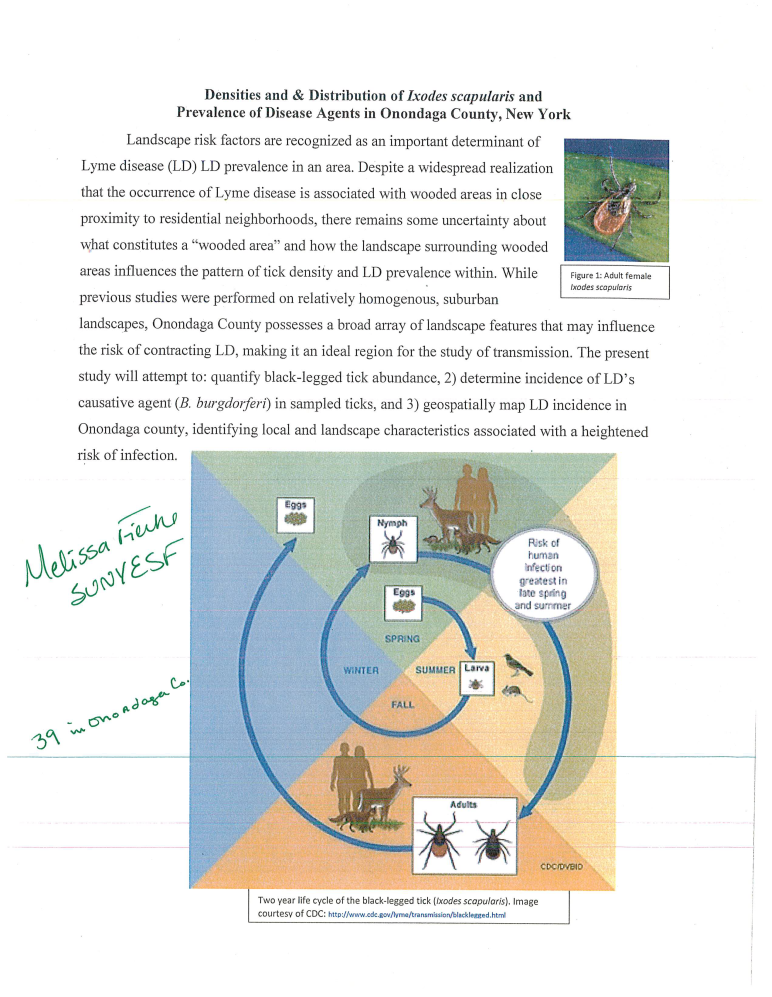
- Ticks will be sent to DOH in Albany for testing, hope to have additional data by fall;
- Next year hope to zoom in on neighborhood with higher density and identify landscape factors associated with the ticks and prevalence of disease along with reservoir hosts which are white-footed mice
- Public needs to be informed about controlling white-footed mice
Mr. Underwood:
-
Has done this for 30 years, worked in 100’s of locations, dozens of municipal, state and national parks, national wildlife refuges and sat on 6 science advisories relative to deer management, most of what he does is dispelled the mythology associated with Lyme disease transmission, i.e. best way for managing disease in humans
-
3 areas of conflict for managing deer populations in urban areas:
-
Personal health and safety issue – Lyme disease part of this
-
Nuisance abatement issue – serious quality of life issues for people
-
Broader effects of over populated deer on things such as green infrastructure – deer population has tremendous capacity to effect natural regeneration of green spaces, i.e. MA instituted major deer management action to protect water quality for the City of Boston as deer were interfering with reservoir
-
Would still have Lyme disease if all deer were removed, does help; took 15 years to document Groton, CT study, large reporting issue also goes along with presumed lowered prevalence of Lyme disease
-
Many other reason to consider managing deer population; would not leave anything off the table, would want to explore all options from personal hygiene around homes and on person, prevention, managing the small mammal population, managing the tick population, to potentially managing the deer population, controversy and expense go way up as one moves down the list toward deer
Chair Liedka said that he believes managing the deer population is complicated and he is going to ask the Law department to look into it. Per the DEC, his understanding is that the local municipality is responsible. There are towns, villages, city, and county borders and within those borders the locality is responsible. He asked if there was somewhere that had success with a united effort to lower the population and how did they do it. Mr. Underwood:
- Many municipalities are managing deer throughout the country and especially in the northeast, leadership tends to be at the county level, tremendous economy in scale if all affected municipalities work together with leadership at the higher government level, tends to be far more successful; regional problem, all stakeholders need to be at the table
- Can be done, requires resources, once started can’t stop, doesn’t mean each year - can design plans to stagger management approaches to optimize resources
Chair Liedka said that he was looking for clarity on lowering the deer population. Mr. Underwood:
- Lowering deer population is one way to manage Lyme disease, it is not the only way he would choose
- Depending on location, usually have combination of approaches, where legal promote hunting through regular big game harvest season and culling, i.e. many Midwest cities have bow hunting inside city limits, must meet certain parameters, not every location amenable; culling usually done by USDA APHIS, contract to meet specific management goal
- Some locations tried fertility control; worked on Fire Island National Seashore for 20 years, implemented key piece of fertility control for 17 years, island 35 miles long, ½ mile wide, not like every other place in the country, can be done, could be fertilization piece on the table; can’t use this option by itself to reduce deer to the scope talked about her
Mr. Moroun:
- Became Syracuse councilor for the Eastside 6 years ago, issue was primary in his district, held meeting 3 years ago at Nottingham High School, 225 people attended, same year had 25 people attend $750 million budget hearing for Syracuse
- Have spent a lot of money to spray for EEE, spent a lot of money on the ash borer
- 3 things – 1) Lyme disease itself, 2) Deer management and 3) Public education; believes the public is already ahead of them, don’t think they as a community have responded appropriately - started at local TNT meeting, did survey on eastside to see what they were dealing with, lead them to Mr. Underwood who provided information at the Nottingham meeting, taskforce jointly appointed by the county executive and mayor, made recommendations to the county executive and mayor and essentially died there, constituents continually ask what they are going to do with this, crying for help, looking for elected to do something
- Won’t solve this today, hopes to come away with a joint effort of the City and County with engagement of local towns and villages, public health and safety issue in terms of Lyme disease, deer management and the economics of it; have a moral obligation as elected officials to address this issue, wealth of information out there, simply must act more aggressively
- Need to find the resources and understand that it will be on a continual basi
Chair Liedka said that they knew how to execute the trees and the spraying, and new what it would costs. He would like experts to tell them how to manage this and how much it is going to costs, then they could talk about this as a larger body. Until they have the information, he does not know how to move this forward. He has heard this problem for at least 12 years. It is a big problem where he lives also. Ms. Williams agreed that they need to listen to the experts. They have had many meetings, conversation and presentations with regard to the ash borer and are still getting information. They have to figure this out - they find money for other things and this is huge in just about everyone’s district.
Mr. Moroun said that he believes the plan really needs to come from the County. Chair Liedka said that he did not have an issue digging in and working with Mr. Skeval and their friends at ESF. His first move will be to reach out to the DEC for direction. Mr. Moroun interjected saying that the mayor wrote to the DEC asking for some guidance and they basically but it back to the municipality to address. A copy of letter was distributed to the committee (On file with Clerk).
Mr. Moroun said that they need to have the DEC engaged with this because they cannot do anything without them. Chair Liedka said that he does not count on the DEC to provide dollars, just direction and ideas, along with the other assets they have, if the assets are interested.
Mr. Moroun said that they might need to find some money between the two legislative bodies to come up with a plan. Chairman McMahon said that he was eager to participate in the process. Chair Liedka said that he and Mr. Moroun would get together and map out a game plan, set with dates. They are coming up on the county budget and he would hate to have the can kicked to another year.
Mr. Burtis:
-
Represents the Town of Cicero and part of Manlius; met Mr. Maroun at Tully deer population study, has been in contact with woodland ticks and deer ticks, had multiple ticks on him and has taken them off, relatively life changing experience knowing what he knows about Lyme disease
-
Friends live in Manlius near Green Lakes State Park, wife has Lyme disease; was told every dog in their neighborhood has Lyme disease
-
Told story of a mother that asked that her son be checked for Lyme disease, shaved his head and found bull’s-eye, short of this there was no proof
-
Has paid a lot of attention to this issue, already made his mind to move forward as quickly as possible; understands all the issues but will choose a human over an animal every time
Dr. Chase said that no one has a problem killing mosquitoes. There has been some pushback on removing trees but nowhere near the pushback they will get when they talk about killing Bambi. Intellectually they know how dangerous this disease is but they are still going to get people who will say that killing the deer will not make the disease go away and they will still have Lyme disease in the area. They need to be prepared for the pushback as this is a very emotional thing for some people.
Mr. Moroun said that they need to be inclusive, with animal rights individuals involved in the discussion. Chair Liedka said that he agreed and asked Mr. Skeval to speak to this, as it came up before. Mr. Skeval said that Cayuga Heights was a model of how not to approach a problem. When they know there is apposition they need to get those people involved in the solution from the beginning, as opposed to walking into a room feeling that a decision have already been made. Otherwise they will have people with the financial means and will to become obstructionist and they will never get to the outcome they are seeking.
Chairman Liedka said that he was going to take the bull by the horns and create a taskforce. He asked that anyone interested in being on the taskforce send him an email, noting that they need a diverse group, not just elected. He looks forward to partnering with Mr. Moroun to find a solution.
The meeting adjourned at 11:11 a.m.
Respectfully submitted,

KATHERINE M. FRENCH, Deputy Clerk
Onondaga County Legislature
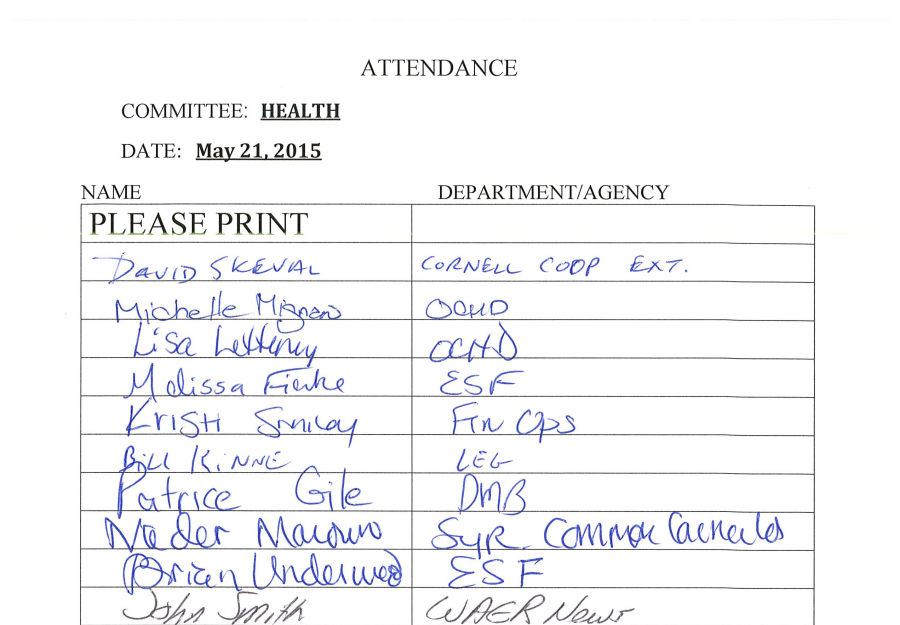
* * *
WAYS AND MEANS COMMITTEE MINUTES – MAY 26, 2015
DAVID KNAPP, CHAIRMAN
* * * |








































































